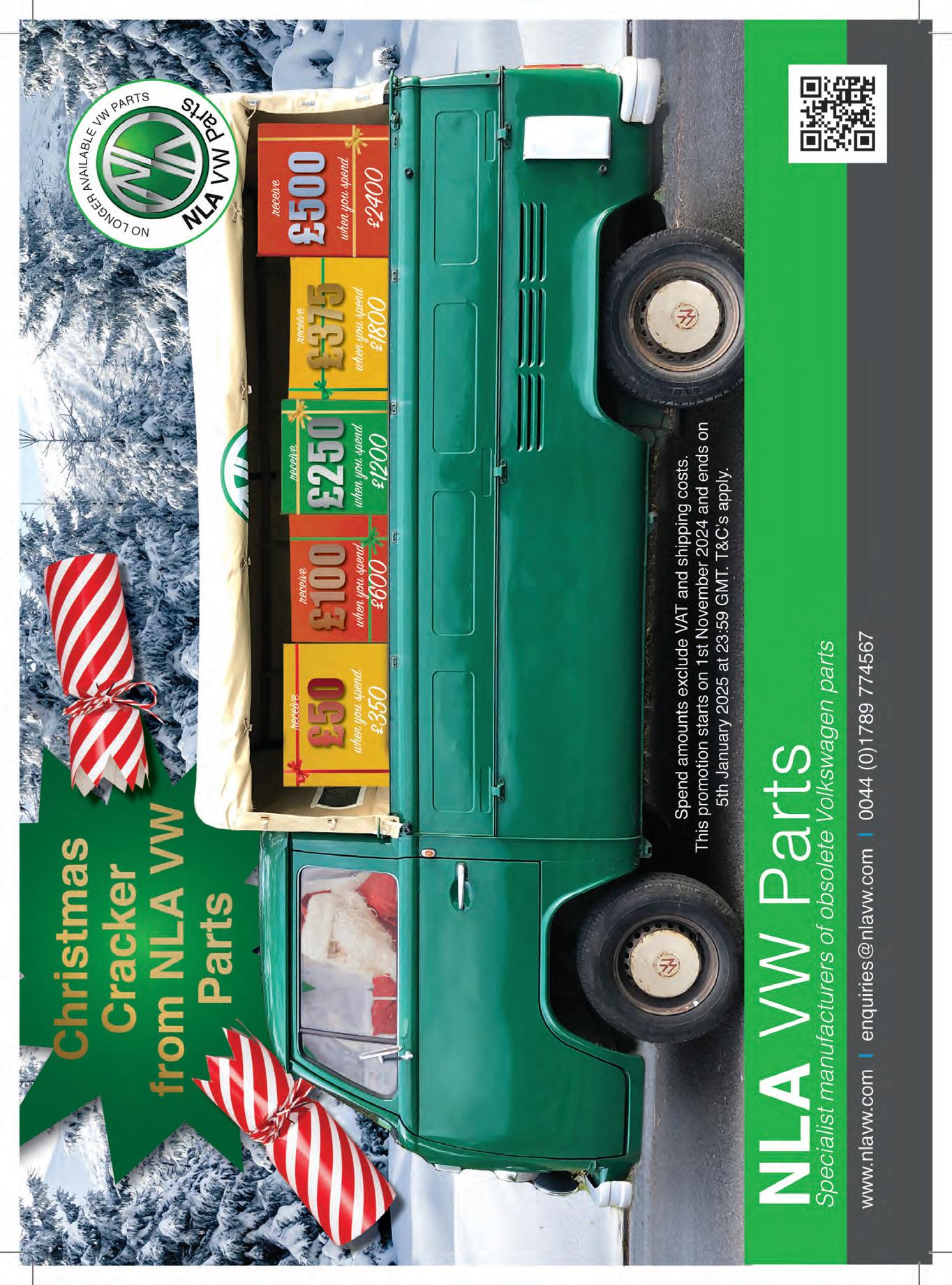














































SJ Bowles Coach Trim
Mad Matz
Paruzzi
FiftySixDelux
Muddy Fields
MCJ
Es Autos
Aircooled Auto Elec
Oil Can Stickers
Deluxe Resto
Retro Classic Clothing
Wonky Donkey
Emporium
VW Aircooled Works
Concept Poptops
Evil Bens
German Junkies
Aircooled Accessories
Growl & Grandeur
Rarebreed
Photography
Beetlelink
Border Restorations
Camper Revamper
Geek Shack
Rack Shack
OB1 Clothing
Johnson Autoworks
Rusty Lee
The VW Engine Company
Alive & VDubbin
Joe Blow
Central England
Automotive
Autowares
Delilah’s
With special thanks to Rikki James, Dan Du Cros, Barbara Faux, Neil Mabbley, Giles Marchant, all the guys at HR Autoworks, Hubert Tilley, James Peene, Ben & Jen Robertson, ThreeFiftySix, Kenneth Anno, Matt Balls, Neil @ Toad Transport, Raphael Meyer, Devo Chiedere Al, Pete Marshall, Jonny Abbott, Nick Chivers, Indra Hernandi, Kustomfest & Rais Maulana, Robert “Rorky” O’Rourke, Chris Wilburn, Jole Coupland, Micheal Gross, Andrea Camilleri all in RSVP, Collin Miles, Craig Pearson, Joshua Smith, Marrion Taggart, Ryan Cox, Terrence Jonny Marriage, Nook_2m, Eric Deen, Tania & Russ, Chris Pruden, Stuart Baker, Billie Stevenson, Michelle Samat, Iain Wickes, Etty & Amelie, Cazz Foster, Teresa & Georgina Iwasiuk, Trint Eastwood, Mark Hutchison, Rob Amos, Alex & Lou Leiserach, Jo & Paul Archer, Mark Thurston & Wendy Clegg, Nell Baker, Sam Lindsay, Dan Morrissey, Jen, Stevo, Brian Galpin,




Bryan Moody, Lew Savage, Ben and Mo Laughton, Nick Gatt, Craig Petty, Eric Arnold, Frederic Peeters, Pete Cobbe, Toby Lee, Heiko & Liv, Lloyd Jackson, Tish & Jack, Ashley Gratton, Joni Makepeace, Bob B.B.T, Bart and Alejendra @ Kombi Brazil Rob Mullner, Brett Elesmore, Graham Wells, Dave Mlynski, PJ Gibbons, Ian and Sophie at Es Autos, Joss Ashley, Elfin and Indie, Jess & Si Medlicott, Steve Walker, Orb and Izzie, Kenneth Anno, Lee Skelton, Steve Gosling, Mark Reynolds, Josh Reynolds, Joe Halliday, Trevor Sharp, Cheryl Dilley, Caroline Soons, Sally & Toby Walker, Helen & James Waller, Jasper Tattersall, Gilbert, Drummer Matt, Julietta Arden-Taylor, Danny Lord, Seaside Neil & Lyn, Jo Pro, Honor Auld, Bill Pollard, Chez Williams, Markus Hoffman, Alan Scott, Gary Kennedy, The Carter Bros, Scott Mitchell, Ian Wheeler, Techno Hippy, Ben Foot, Mark & Odette Watts, Rich Whitlock, Jeffrey Van Duin, Angie Simmons, Grum & Leanne, Steve Parsons, Claude Schaub, 10 Foot
Doug, Randy & Vanessa Carlson, Barry Morrissey & Ewan McGregor.
And to everyone who has submitted, contributed and supported us, none of this could have been done without you. Thank you.









126

It was now or never, and with the help of many online tutorials Paul started to remove the layers of the hood. It went pretty well, with the advantage of a complete top to start with giving valuable reference points.


Having been a prominent figure in the VW community for a good few decades, we wanted to learn how it all started for Rikki.


192
Just to clarify, I will complete this car. I have to complete this car. It just might take a little longer than first expected.
130

What we are looking at here is the brainchild of owner Allun Tugwell and product of the hands of Jamie Franklin. Jamie, for those that don’t know him, runs JF Bodyworks in Banbury, a bodyshop specialising in body and paint work for classic Volkswagens.



84
46 104

I think the best two things about Classic VWs are building them and using them – whether that is attending shows, knocking about locally, a cruise with mates or, best of all, travel adventures.

72
This is a feature about when a vehicle becomes much more than “just” a vehicle. This isn’t an A to B vehicle – nope, this one is the whole alphabet

60

The car is originally from Sweden and was owned by an old couple. Unfortunately the old man drove it into a tree. After the accident the car was tucked away in a barn for years.


The idea of this article was to draw the front and rear of every year Type2 bus and list the aesthetic changes.
Copyright © 2024 by Hayburner Limited. All rights reserved. This magazine or any portion thereof may not be reproduced or used in any manner whatsoever without the express written permission of the editor, except for the use of brief quotations.
Operations Manager - Vic Faux Editor-In-Chief & Founding Editor - Ned Faux


When you want to talk about Volkswagen Powered Bianco’s who do you go to? You go to visit 93 year old Toni Bianco in Brazil of course! That’s just what we did.


The welded shell eventually made its way to my good friends at Beetle Magic near Dorchester, but you guessed that already, I imagine. Once you find good people, skilled people, honest people, friendly people, to work on your cars, then you don’t change the formula.

It’s taken me over 10 years to get round to writing this. The reason it’s taken me so long is that the subject is a bloody minefield!


For the shell, Jerome decided on a colour change from Savannah Beige to something a little bolder. He chose Porsche colour Aquamarin Blau.





Only Steve doesn’t see dead people; he sees style and potential hidden in mundane or unloved vehicles long before they become the next big thing.


The bus was used as a delivery van, to pick up radios and TVs for service, and he drove it from his home to the shop until 1968. It was mainly driven on gravel roads


















Brent Adam Pendlebury




James Murtough
















Andrew Smith








Andy Finch



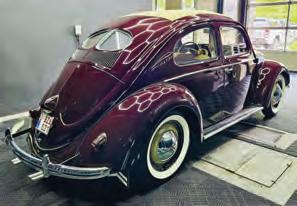


Simon Gallimore









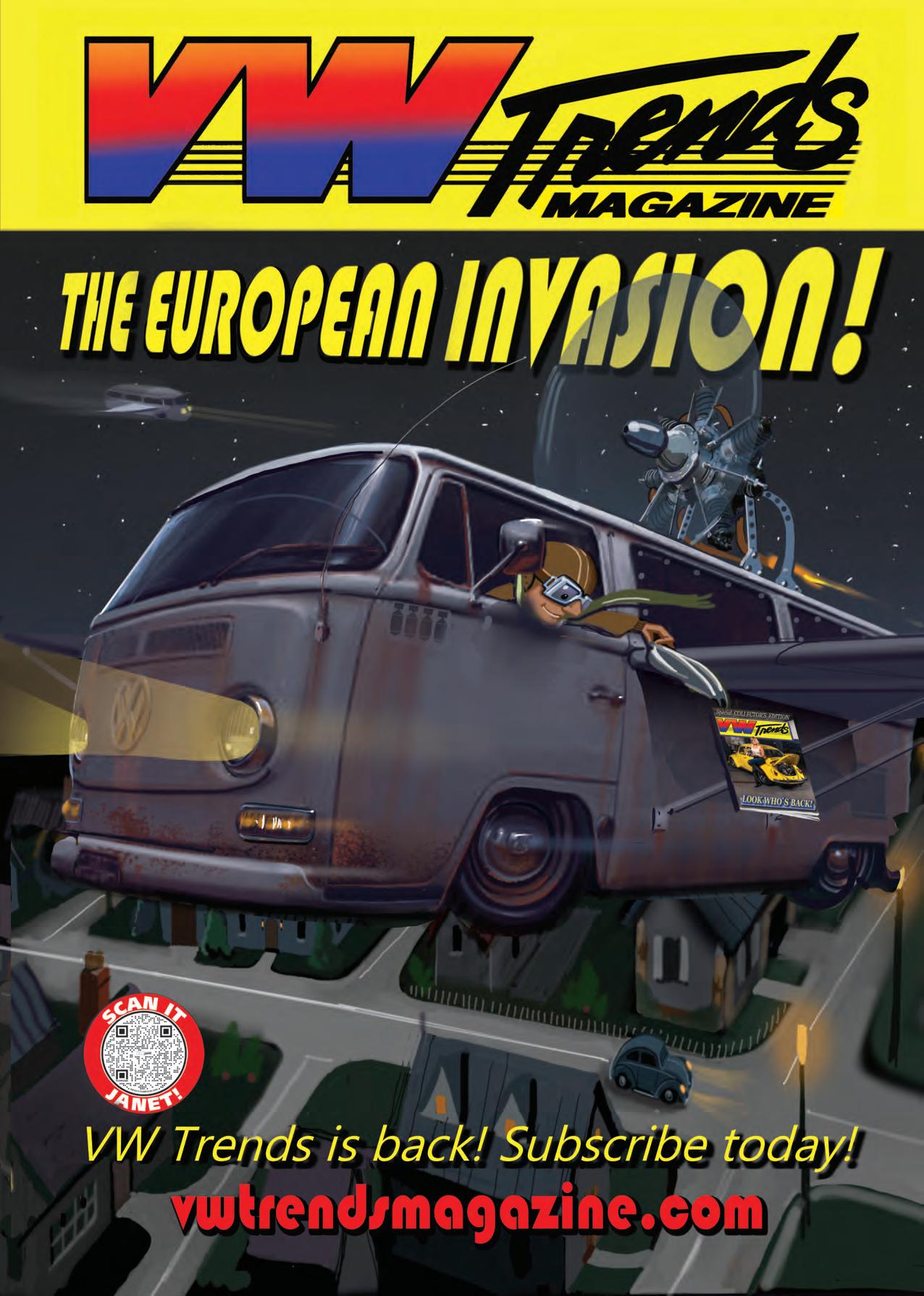

PHOTOS BY RASMUS KRISTOFFERSSON
Q: Let’s start at the beginning. What’s your name, how old are you, and where do you come from?
A: I’m a 29-year-old guy from Helsingborg, Sweden, who has a burning interest in old cars, mostly VW and Porsche.
Q: What’s your day job and do you have any other hobbies?
A: I’m an entrepreneur. I don’t have time for more hobbies than six cars, a girlfriend and my job.

Q: What’s your ultimate VW/Porsche?
A: I would say that a Split Window Panel is the ultimate VW. It’s so useful and cool.
But I would love to own a Type34 because that’s the best looking car VW ever made, if you ask me!
Q: Favourite VW event?
A: I haven’t been to that many VW events, but I’m looking forward to visiting more events in the future. One of my dreams is to drive
the Philips bus to HO26 and that’s the plan!
Q: What got you into Volkswagens and how many have you owned before this one? Can you list them all?
A: It all started with a 15-year-old boy who wanted a car to play around with. My parents weren’t too happy about that, but at last they told me that I could buy an old simple car like a Bug. We didn’t have any garage at that time. Then one day I read an article in a Swedish magazine called Bilsport about two young brothers

who owned one 1303 with 2332cc each, and I was amazed by them. Finally in 2011 I found my first ’65 VW Bug. I parked it in a barn for some years. Today it’s a restored Cal-looker with a big engine and still in my collection.
’65 Bug, ’73 Bug, ’63 Ragtop Bug, ’60 Split Panel, ’85 Sika Syncro and an ’87 T3 Bus. I still have them all except the ’73 Bug and the ’87 T3 Bus.
Q: Who, or what, would you say is your biggest influence in the worldwide VW community?
A: I get my inspiration from magazines, Instagram, the internet and

local meets.
Q: Best moment during classic VW/Porsche ownership?
A: My best VW moment was probably when I found and bought my Split Panel.
Q: Worst moment during classic VW/Porsche ownership?
A: The worst moment was probably when I lost oil pressure in my ’78 Porsche 911 Targa on my way to a meet. Luckily it was just the gauge that let me down.
Q: So, what is it we’re looking at here (year, spec and model)?
A: This is my beloved LHD 213 VW Delivery Van with left cargo doors, produced on 8 September 1959. 1960 year model. It left the factory in primer inside and out with grey upholstery. The car had the famous “bastard” engine originally. The car and the logos were painted in Sweden when the car was new. All logos are original and untouched.
Q: What’s the story? How did you get hold of it?
A: I bought the bus on a marketplace called Blocket in Sweden in Easter 2017. My father and I drove to Borlänge from Helsingborg to pick it up on a trailer (600km each way).

Q: Did the vehicle come with any history?
A: Gunnar Svälas bought the bus new on 17 December 1959 for his radio and TV service company in Orsa. The bus was used as a delivery van, to pick up radios and TVs for service, and he drove it from his home to the shop until 1968. It was mainly driven on gravel roads. In 1968 the bastard engine broke down and the warranty had run out. Gunnar was not happy about the VW warranty and parked the bus in the family barn with only 36,000km on the gauge and bought a new car instead of repairing it. Gunnar passed away in the mid- or late 1970s and the bus was left in the barn. Then in the late 1990s or early 2000s a VW enthusiast bought the bus from Gunnar’s brother. Then it jumped around to three different VW

enthusiasts but no one did anything to the bus before I got hold of it in 2017.
Q: Tell us about the condition of the car when you first got it home.
A: The bus was complete with all the original parts except one blue rim. The original bastard engine was still in the car. The standard rust was there, like bottom doglegs, bottom nose under bumper, b-pillars, parts of cargo floor, rockers, outriggers, jacking points, heating tubes and the rain gutters around the roof. The paint has


never been repainted or anything and I’m super happy about that. Even the original owner’s cigarettes were in the ashtray.
Q: Run us through the restoration/recommission. Who did the work?
A: I started the process of restoring the things that needed some TLC on my own in 2017. Then life and other cars came in between and the project stopped. In December 2022 I started the project again. I have done all the work on my own, like cutting, welding,
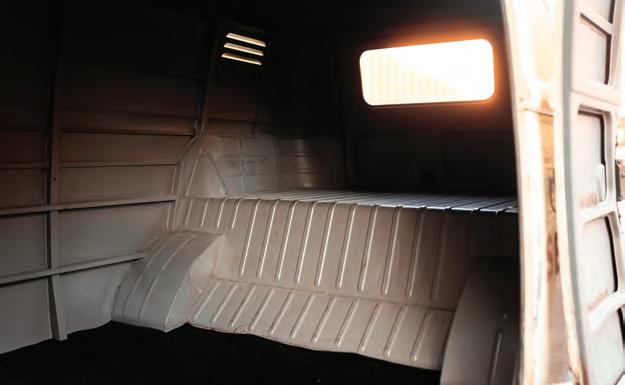







bodywork, rebuilding the engine and assembling everything. My father helped me with the old electrical system that needed some TLC. In October 2023 Steve Parson (the patina blender) flew in from the UK to help me with the blending. In December 2023 the bus was registered in the Swedish system again after 55 years standing still. During the winter I built a new engine for the bus to be able to make some European trips.
Q: Paint colour (and code if you know it)?



Q: Run us through the exterior.
A: The exterior is super original with logos. Auto Wares convex mirrors are a great upgrade! I don’t know what to say more than that.
Q: Suspension and brake set-up?
A: Suspension is totally original. I haven’t needed to replace


anything else. Standard Bilstein shocks. Brakes: CSP master cylinder, CSP disc brakes in front and standard drums in rear.
Q: Mechanicals?
A: Everything mechanical has been gone through so there is nothing that doesn’t work.
Q: Wheel and tyre type and sizes?
A: 15” original crowsfoot rims with Firestone Deluxe Champion 6.40-15 Bias Ply. Grey hubcap with blue VW logo.
Q: Gearbox?
A: Original gearbox, just cleaned with new gaskets and non-split axle tubes.
Q: Engine?
A: The engine is an industrial 1600sp engine. Everything has been gone through. Rods and pistons were weighted within 1 gram, crank and flywheel were balanced, heads were lightly ported, new sleeves and valves and seats machined. New bearings and much more. CSP pacemaker dizzy. Restored original fuel pump. Solex 30 pict-1. The engine tin was made to look like the original for the bus. Even converted to state air heating. Used on cars up to 1962. Runs great! The original

bastard is intact on the shelf because it’s very hard to find parts for it.
Q: Have you replaced the electrical system?
A: The wire harness is original but I have gone through every little connector. Of course still 6 volt!
Q: Were there any parts that you found it hard to get hold of?
A: Parts for the bastard engine are almost impossible to

find. It’s not a very good engine anyway so it can sit nicely on the shelf.
Q: What is your go-to VW parts shop?
A: I bought most parts from my local shop, “Custom and Speed Parts in Hyllinge” or CSP Germany. I needed sheet metal and I have used Autocraft and Klassic Fab.
Q: Run us through the original interior.
A: The interior is very original with a lot of signs of age and use,


but everything is like it was when the car left the factory. Not even cleaned. It’s not a good idea to wear white or bright clothes in it.
Q: Accessories?
A: Not too many accessories in this bus. Original tools and jack. Some old advertising from the TV and radio service. Auto Wares convex mirrors and mirror clamp covers.
Q: Have you got a stereo fitted and, if so, what are you currently listening to (either in the car or during those late nights in the
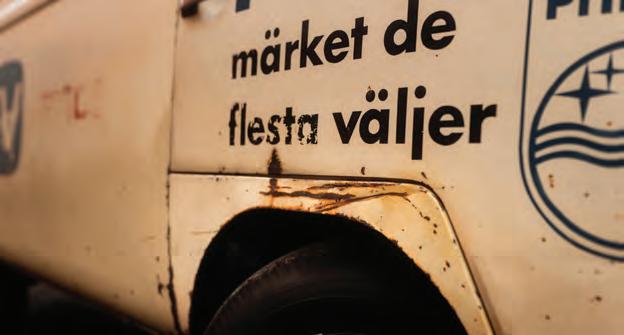

workshop/garage)?
A: I don’t have any stereo. I like the sound of screaming reduction boxes, hehe. Outside of the bus I listen mostly to old music from the 80s. But I can listen to and enjoy most music.
Q: What’s your favourite thing about it (e.g. wheels, paint, detail, trip it’s been on, memory with it, etc.)?
A: The thing I love most about this bus is the originality and people’s reaction when they see it. I have many cars but in this one I get a lot of thumbs up and honking and waving. Super fun to

drive.
Q: If you had change one thing, what would it be and why?
A: I think the car is perfect as is, but if I have to say something … if I knew how much fun it would be to drive the bus, I would have finished it quicker!
Q: What’s next for you and the car?
A: Next up for me and my car is to drive and enjoy it!
Q: How often do you use the car?
A: I have driven it 2000km this summer and I’ve tried to drive it once a week during the summer.

Q: What’s your next project going to be?
A: My next project is going to be my Turkis Ragtop Bug from ’63 with sweet patina and Judson supercharger.
Q: Who would you like to thank connected to the project?
A: Big thanks to my father as usual for his support. Thanks to Mårten Ilmstrand for supporting me doing bodywork for the first time! Thanks to Stefan at Farm Shack Garage for adjusting the engine top notch. Thanks to Göran at Logmech for the machine work on the heads! And a super big thanks to Steve Parson who packed his bags in the UK to help a total stranger blend his car in a foreign country. Thanks again, Steve!



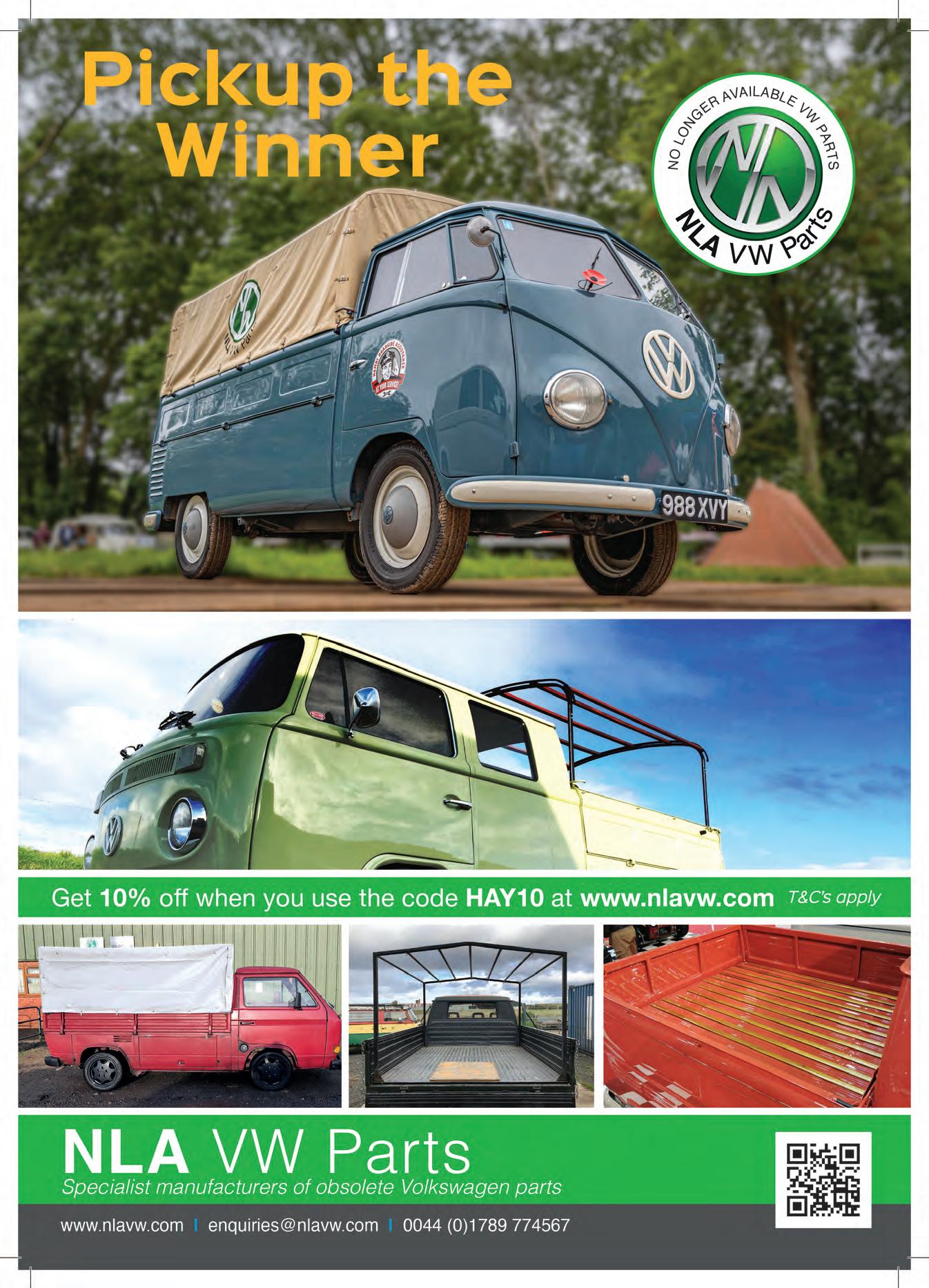



Steve Murphy has a special gift – similar to that kid in the Sixth Sense movie.
Only Steve doesn’t see dead people; he sees style and potential hidden in mundane or unloved vehicles long before they become the next big thing. He also has an uncanny ability to visualise fine detail, and then with a couple of tweaks turn the sublime into the super cool. And he has been doing it for years.
I have known Steve for a long time so I’m kind of blasé about his sixth sense, but I literally can’t think of any vehicle he has owned that hasn’t been taken to another level one way or another. And as he is a compulsive petrol-head, that’s a lot of detailed thinking, and a lot of cars. It’s not all radical modifications either – a change of wheel colour here, a bit of de-badging there, and a mind-bending mix of style influences. US Kustom, Race, Japanese Retro, the list is endless. Cross-referenced
from his internal library of cool, they all combine to aid and abet the final creation. Perhaps he visualises vehicles as art and can instantly plan out a finished piece? Or maybe he just sees cascades of weird digital stuff like the Matrix? Whatever the reason, he makes it look so easy that there is definitely something going on.
His tastes are best described as eclectic. Whilst a twist of air-cooled VWs form a sound foundation, there is always some left-field creation in the fold. And for the benefit of this tale there is a bit of Porsche history from a few years back, when the 356A and 914 were infinitely more affordable. Of course, Steve tinkered with them and after a while moved on to other cars. After all, if you have the gift you have to let it flourish. Right?
A 912 was always on Steve’s radar, but as prices rose over the years, the sense that they were becoming out of reach led to a now-or-never tipping point. They have always been a rarer car than people think, with just 4305 coupes produced in 1968. The majority were destined for the west

coast of America, while the remainder slowly edged towards a destiny to dissolve.
The search was on in earnest, and Steve looked at a couple of cars but quickly became aware that they are not created equally. Actually, they were created equally, but the passage of almost 60 years had resulted in shiny cars with poor mechanics, poor cars with poor mechanics, or a combination of the two with crappy interiors thrown in. The stand-out cars were over budget and anyway Steve uses his vehicles, so the cleanest cars were out. (Perhaps the finished car carries a sense of irony, as it’s hardly a barn-find.) But we are jumping the gun, so let’s return to the plot at a point last September, where Steve has spotted a white 8 coupe owned by the Midlands’ most prolific VW hunter and all round nice guy, Freddie Lynch.
What Freddie was sitting on happened to be a reasonably presentable white US-spec coupe. It had seen a few rounds with the west coast climate and although it was born light Ivory, that had long been covered by a tiring white paint job. That’s not tiring as in tedious, just tired, and certainly past its prime. The paint may have been tired, but the engine and virtually every other aspect of the drivetrain certainly were not. In fact, the car boasted a very recent full engine rebuild by marque specialists Revival Cars – upgraded from 1600 to a heady 1720cc, with the whole array of ancillaries restored to suit. If you were

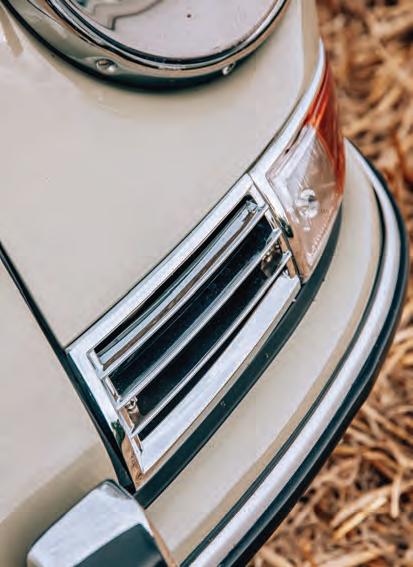
that way inclined, eating your dinner off it wouldn’t be such a bad proposition. The car sounded great as well. Sporting a dual central tailpipe Dansk exhaust, it looked as good as it drove. Basically, all the bits that do the work had been renewed, and all the bits that wear out had been turfed out – brakes, shocks, gaiters, steering components, bearings and so forth. The car was even lowered! Freddy had managed to scoop the 12 from the previous owner and importer with all this work done, and as he handed over a pile of invoices for Steve to peruse, things were looking positive. Thirty-six thousand quid in receipts and invoices sealed the deal, as that equates to off-the-scale levels on the peace of mind barometer. Yes, the body was a bit scruffy, and the interior needed a little Steve magic to bring it round, but remember this guy sees things most don’t. As those digital flashes and future projections



took shape, the deal was sealed and Project 12 was underway.
We all know winter is rubbish, so Steve set about cheering himself up with some additions for the car including a set of coco mats, Prototipo steering wheel and one of those awesome 917-style gear knobs that are turned down from old skateboard decks bonded together. There was some mundane stuff too, but mostly “these things make me happy” additions.
On the theme of happy additions, Steve phoned me one day and was enthusiastically praising the virtues of vintage Cibie Biode headlamps, no doubt one of the random things floating around his thought processes waiting to be allocated to a vehicle. Amazingly, I actually knew what he was taking about, but had no idea what was
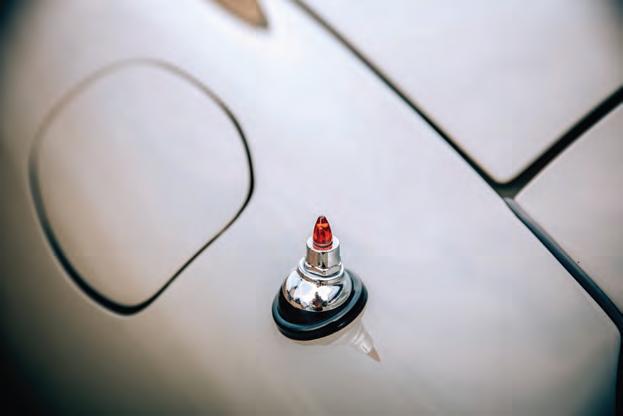


to come a little later down the line.
Now, if one of your oldest friends runs a high-end body shop, it makes sense to try and slip a little Porsche into the mix for a quick “over the top” colour change, so the Monday after Ninove the car arrived at Classworks in Surrey. I know it was after Ninove because I was working as part of the Classworks team, along with “Angus” the owner, Rich who has an unnatural interest in all things Shelby (and a deep disdain of pretty much everything else), and the Naysayer, time served but set in his ways. The usual fare of vintage Astons and Ferraris was put on hold as we rolled the 912 inside and under the lights of doom. Imagine high definition but for car bodywork, where you soon start to spot all the imperfections
and wobbles that are all but invisible in natural light. Unfortunately for Steve, the lights showed the entire car was covered in micro blisters, like tiny goose bumps over the surface and often caused by a reaction in the primer solvents, moisture in the paint or just exposure to climate. The remedy is generally pretty drastic. It wasn’t going to be a quick “scuff n puff”, that’s for sure.
While we did our thing and started to bare metal the car, Steve did his wheel thing and detailed a set of the popular Group Four American Racing repro’s. Only he didn’t like the machined outer rim, or the texture, or the colour! Which meant he had to prep and etch prime the offending shiny bits, then apply a textured finish to the wheels before finishing them off with some heavy duty

satin black. All good wheels need tyres and Steve scanned his data banks, settling on a set of period-esque 175, 70, 15 Brockleys. A super-cool tyre, and a back story that invites further investigation. If the sound of a historic racer being so disgruntled with the contemporary products on offer that he decides to make his own floats your boat, you know what to do.
It was evident that some of the rubbers, trims and fittings were past their sell-by dates, and as the tear-down snowballed so did the endless procession of deliveries showing up at Classworks. It got to be like the scene in Goodfellas with goods pouring into the restaurant, only in this case they were not leaving out the back. I tell

a lie. The front seats were actually sent down to Garry at Classic FX for a correct grain re-trim and period Pepita (houndstooth) inlay. Curiously, the headrests came from a little further afield – from Seattle, in fact. Eric at Auto Foreign Services retails the finest artisan ’65 to ’73 911 parts available. His steel horn grilles are a work of art, so a pair kept the headrests company as they headed over the pond. A dash-top from Germany, door catches from Holland, window trim from Exeter, door felts from Essex and a bit of old Beetle sealing strip from my shed … relentless!
For those of us toiling on the car it became apparent that some metal work was required. Nothing mega drastic but some
isolated rust repair to the front wings, sill tops and a seal retaining panel. (Basically, I pulled the front hood seal off and the car came with it.) Shelby Rich is a metal maestro and I can think laterally, so as the replacement panel was out of stock we combined our tiny minds and made one from scratch. The only other welds occurred where the ’68-only side reflectors were sacrificed from the rear quarters, down towards the tail lights. And still the deliveries kept coming.
Remember the Cibie Biodes from back there somewhere? Well, a pair turned up and I was given the thankless task of making them fit into US-spec wings. Spoiler alert: they don’t! Obviously I got them in
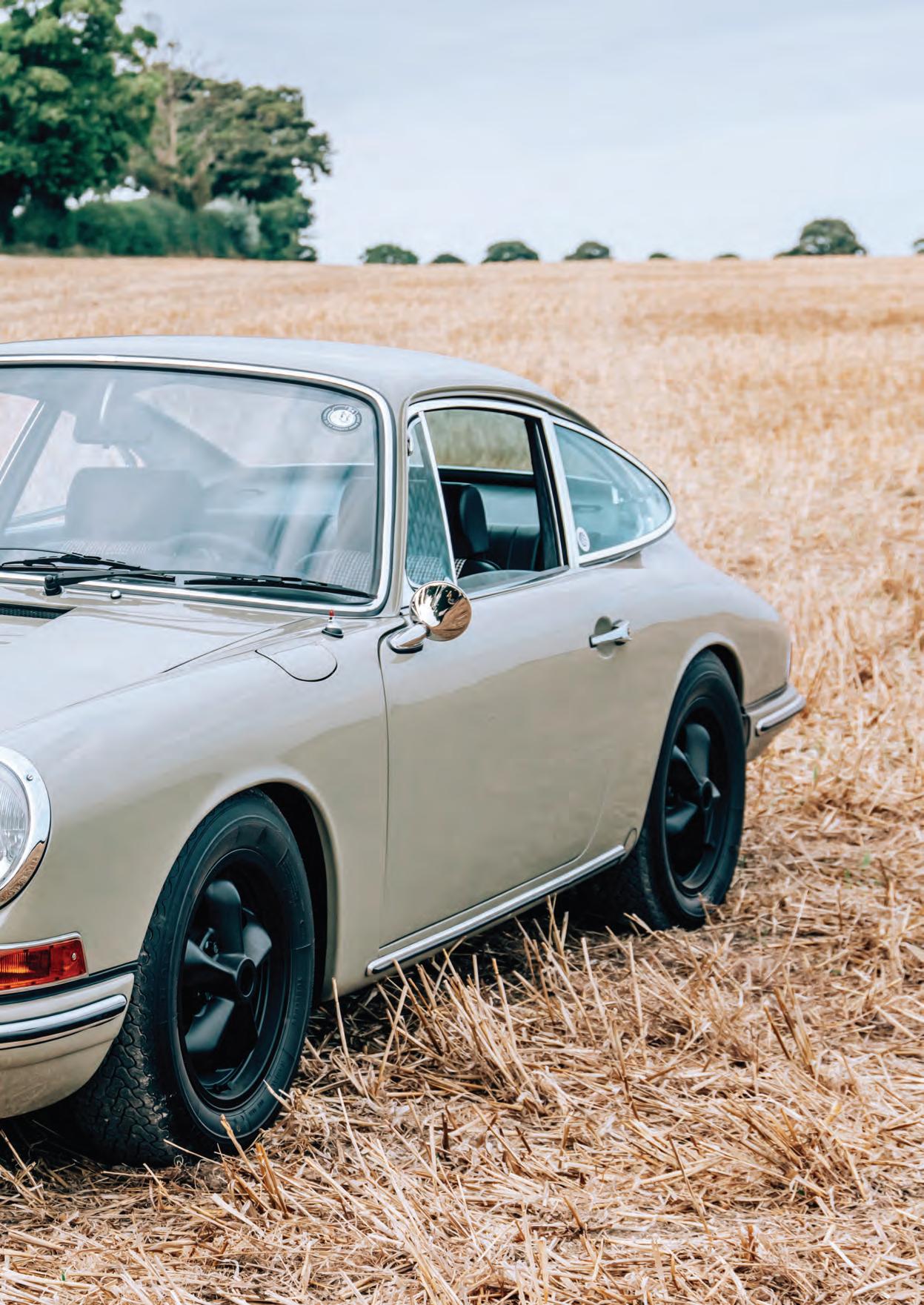
eventually, and once you notice, they certainly look the part. It’s another detail only Steve would dream up, and one I am glad we trial fitted before the paint went on.
I’ll get to the paint in a moment, but I wanted to acknowledge the folks up and down the country who prep and paint these old things day in day out. Dealing with mangled bumpers, dints, scrapes and almost 60 years of dodging around, it is a full-on mission at times, and this car (even though we blitzed it) took four weeks to get into colour (that’s what painters say; I was only a prepper/masker/dogsbody so I’m just using the opportunity to sound like a pro).


The actual colour (applied by Angus) is a 1957–1959 356 shade called Stone Grey*. And if you think that is a stretch of the imagination, the other colour Steve had in his detail-laden mind is called Lido Gold. And that, my friends, is well worth a Google, because it bears absolutely no resemblance to gold (and is also one of my favourite Porsche colours). Perhaps it’s German humour?
*Stone Grey/Stein Grau Code 5710. Mac 1 direct gloss by Lechler, applied over epoxy and primer coats, also Lechler products. [–Because one of you will be wondering.]
I’ll skirt over the fitting-up process, but as I am partial to a Porsche, have a bit of previous with the things and like telling people what



to do, it was a really enjoyable week putting it back together. The other guys probably have a vastly different opinion, but as the piles of new parts and fittings dwindled it started to look really cool. Even the Naysayer started to thaw a little.
Steve picked up the car, sans front seats and a few other parts he had removed prior to leaving it with us. And off it trundled into the trailer, looking a little forlorn on the original battered steel wheels. Which is probably why I didn’t recognise it at Classics at the Clubhouse in June. Steve had super-detailed and cleaned the car, fitted his AR wheels, the awesome new seats, a red tip aerial and a couple of nods towards the slightly earlier cars in the form of a green dial rev counter and chrome interior and exterior mirrors. In 1968 Porsche started to move away from pointy chrome interior fixtures and the traditional green instruments in favour of safety-
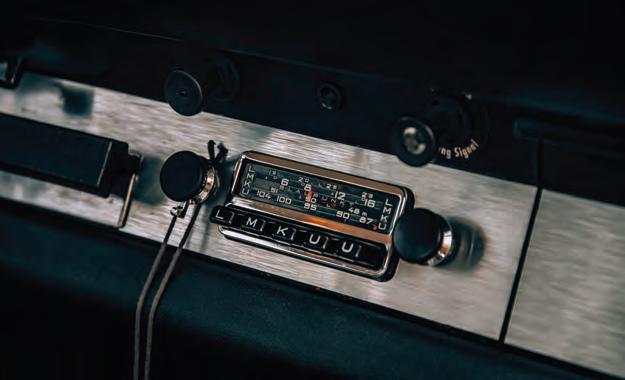


inspired fittings and a new “modern” black dial format. 1968 was the crossover period. In 1969 most deeds were done, the cars were lengthened, and the 912 was to be no more. But the earlier more dangerous pointy parts are stylish, and style is what he does after all.
The car really looked fantastic at the clubhouse, managed to pick up a trophy in the process, and made the round trip from Peterborough (ish) a memorable first outing. It repeated the award-grabbing feat at Skeg Vegas too, and I lost count of the people asking if I had seen it, and who owned it, which was pretty cool. I am used to Steve knocking up something that people notice and appreciate, but this time his ideas and mix have really hit the spot, so much so that it drew a steady stream of admirers at the Ultra Porsche event, Boxengass – where some of
the rarest and most desirable air-cooled Porsches in Europe rubbed shoulders with the only Stone Grey 912 there.
The future looks bright for the 912, but Steve just can’t help himself. When we were discussing this feature he told me about his new Notchback and how he was going to … well, you get the picture.
The appreciation list starts with Ann, for putting up with the automotive shenanigans, Angus Bromfield @ Classworks for shiny shiny, Alex Leiserach who not only dragged the car up and down to Surrey but is a top bloke, and Ian Clark, who has had absolutely nothing to do with the car – yet.

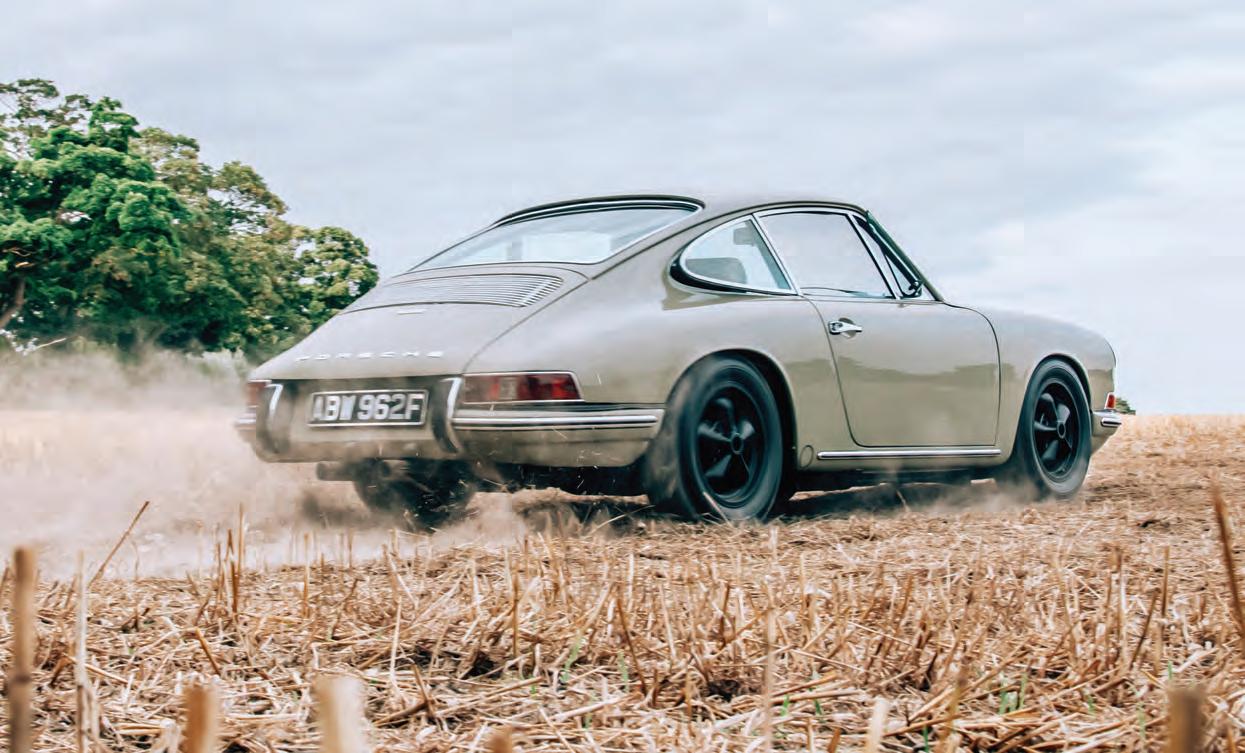

WANTTOADVERTISEHERE?PLEASEEMAILadvertising@hayburner.co.ukFORDETAILS


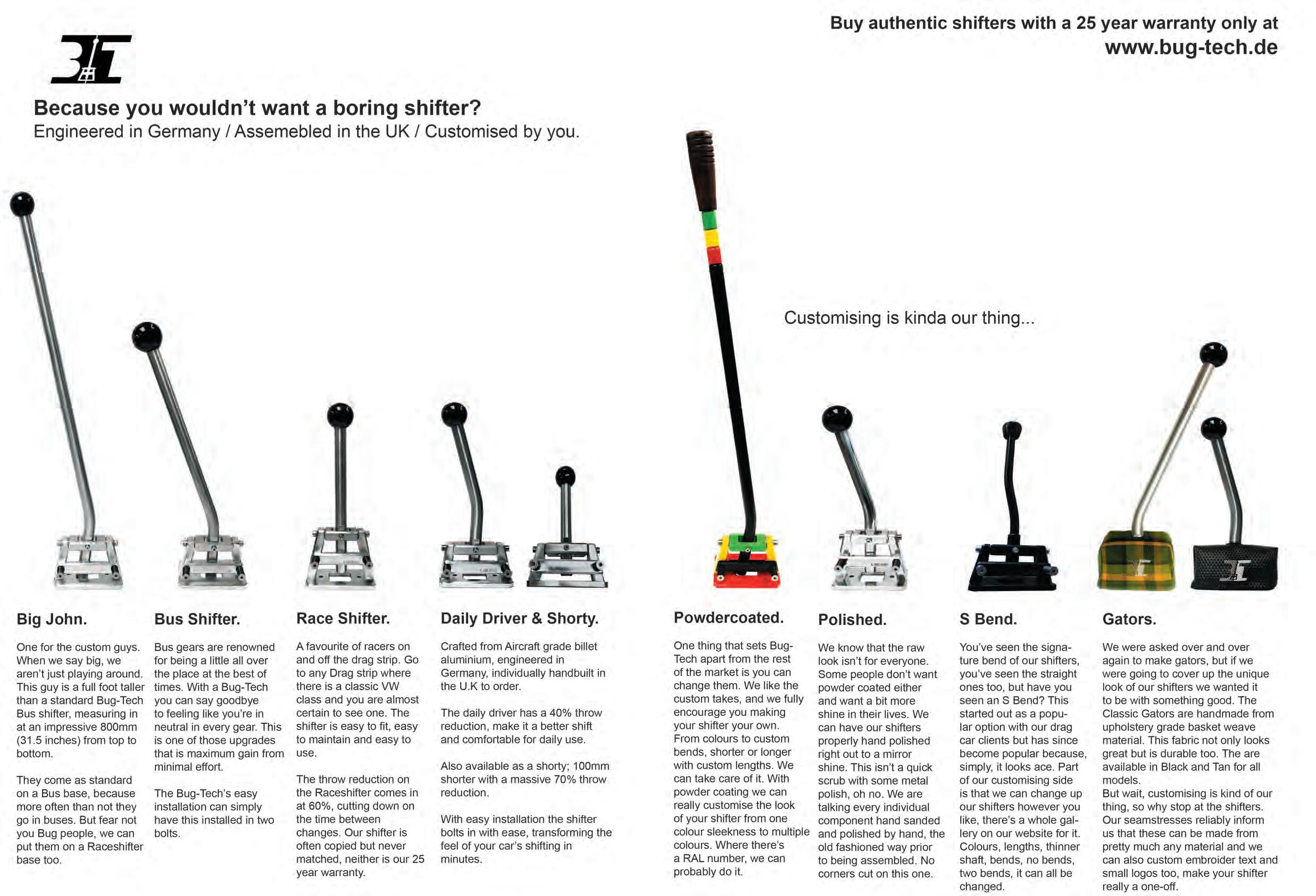





BY NED FAUX
The idea of this article was to draw the front and rear of every year Type2 bus and list the aesthetic changes. I’ve had to limit it to aesthetic changes because to list every nut, bolt or mechanical change over a 30-year production run would take up the entire magazine. I should also add, before I get an email saying “you forgot the overriders!”, that this article is specific to Euro-spec vehicles, so some changes may differ with regard to Australia, America or some other countries with their own specifications.
Hopefully this could be a useful guide or just interesting for readers to see what has changed and when. This has not been simple. There is so much conflicting opinion out there about this list, but I feel I have come up with a pretty basic guide to the evolution of the Type2.
I’ve never put in so many hours on a single article so I really hope this was worth it! Enjoy.








You may well want to ignore this one. There are no real known survivors apart from the cobbled-together oddity in the Stiftung AutoMuseum, and from what we can tell there is no directly compatible part or panel with any other Type2 model. There are many unique features such as the external fuel filler, strange pressings around the headlights, and wobbly panels. This bus really was a “prototype” only. As well as what you can see from the drawings, the prototypes had upright side vents and shorter roof gutters. Later prototype models were closer in style to the production model but all were unique in their own way.
We’ve heard rumours of an “external filler” prototype bus in the Wolfsburg museum vault, but we do hear a lot of rumours and most of them turn out to be bullshit.
Total produced in - 1949 - 8 (You did read that right, just 8 busses)







‘Barndoors’ The first generation of the type2. Note the solid back window with cast aluminium front and rear badges.



Because of the large engine hatch this is refered to as a barndoor bus. The ‘barndoor’ refers to the big engine compartment rather than the cargo doors, which do actually look like barndoors just to confuse you (this makes zero





The front of the vehicle remained very much the same as the ’50 model.
*Rear window added from Mar ’51

sense to us either.)
Like the ‘49 it’s unlikely you need this diagram with only 43 surviving ‘50’s currently on the register but it’s a good place to start.
Total produced in1950 - 8,059 1951 - 12,003




*Nose badge now made of pressed steel, Mar ’51
1st June ’51 – Deluxe (Samba) was produced. This included a sliding sunroof and 23 windows including skylights and special curved windows on the rear corners.

Total produced in1952 - 21,665

3rd Aug ’51 – louvres were introduced on the Panel Van upper panel.
3rd Dec ’51 – the first Volkswagen Splitscreen Ambulance was produced.



*Second reflector added, Feb 1952
*Mirror arm changes shape (down facing) from Nov ’52
*Number plate light slimmer, Nov ’52 (see ’53–54 model below)
5th Aug ’52 – the first Volkswagen Splitscreen Pickup was produced.
2nd Jan ’53 – the cab door front

Total produced in - 1953 - 28,417


quarter light was changed on the Splitscreen bus for a pivoting unit. The original design before this model included a piano hinge.


*Rear bumper added for Deluxe only, Feb ’53. Afterwards the bumper came as standard on all Type2s, Nov ’53


Total produced 1954 - 40,199




Aesthetically the bus remained pretty much the same until late ’55 (afterwards please see 1955–1956 “Early Split” model below for changes)
*The front panel has indentations for wipers, Jan ’55
*Mirrors now on door hinges, Jan ’55
*Wider gap in ribbed bumper for


The “Early Splits”
*Rear window changes shape, Jan




Total produced1955 - 49,907
bigger number plate, Jan ’55
*Different size windscreens, Jan ’55
*Front roof peak added, Jan ’55

*Rear hatch added, Jan ’55
*Engine lid smaller, Jan ’55
* Small flat taillights (Europe only), Jan ’55
*An extra engine vent louvre (now

Total produced 1956 - 62,500

9 on each side) was added above the rear wheel, Mar ’55
*Wheels became 15” instead of 16”, Jan ’55






*Dollar-style taillight from Apr ’57 (see ’57–58 model below)


*Dollar taillights, Apr ’57
*No central brake light, Apr ’57
Total produced 1957 - 91,993




Total produced 1958 - 101,873




*Engine lid has new pressing, May ’58
*The side cargo door incorporates
a recess behind the exterior handle, Aug ’58
*Taillights in lower position, Dec ’58 (see ’59–60 model below)
*Ribbed bumpers replaced with


*Although earlier in other parts of the world, Euro models didn’t receive bullet indicators until May ’60

Total produced 1959 -121,453
smooth, Aug ’58 (see ’59–60 model below)
Although the Single Cab had been around from 1952, the first Split Double Cab Pickup wasn’t produced until 3rd Nov ’58






Total produced 1960 - 139,919






*Half moon on rear hatch, May ’60
Top cargo door hinges lowered to belt line, Dec ’60


*Bigger taillights, Aug ’61 Total produced 1961 - 168,600 Total produced 1962 - 180,337









*Fried egg style indicators, Apr ’62
In March ’63, a tenth engine vent was added. The vents were then made to go inwards instead of outwards.



The “Late Splits”

Total produced 1963 - 189,294

became a popular factory option
*Bigger rear hatch introduced, Aug ’63

*At some point during the 1960s (we are not sure when), a couple of styles of bigger wing mirrors
August ’63 saw the end of 23-window Samba and 15-window

Total produced 1964 - 200,325


Deluxe production due to the larger tailgate.
In Dec ’63, ice pick door handles were replaced with push buttons.


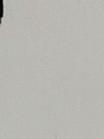
Very few aesthetic changes happened during this time.
In Aug 1966 the first 12-volt Splitscreen bus was produced.


The “Early Bays” In August ’67, Bay Window production begins with new features such as:
*One-piece curved windscreen
*New roof pressing
*Front panel *Headlights





Total produced
1965 - 189,876
1966 - 191,373
1967 - 162,741


*Bumpers *Grill
*Front badge
*Wing mirrors
*Indicators
*Engine lid *Rear hatch
*Upper engine air intake vents



Total produced
1968 - 162,741
1969 - 253,919
1970 - 288,011
1971 - 277,503











The “Crossovers”
*Tall taillights, Aug ’71
*Engine lid brow, Aug ’71
*Fixed rear valance, Aug ’71
*Larger upper air intake vents, Aug ’71



The “Late Bays”
*Front panel, Aug ’72
*Vents
*Indicators
*Bumpers
*Nose badge




Total produced 1972 - 294,932




*Engine lid
*Cab step is now part of the inner arch.
July ’79 marked the end of production. The Type2 was replaced with the all-new (but similar) T3/T25 or Vanagon, depending on where you are from.



Total produced
1973 - 289,022
1974 - 224,993
1975 - 227,087
1976 - 242,352
1977 - 208,615
1978 - 208,615
1979 - 186,870












BY
KENNETH ANNO
WORDS BY DAVY VAN HECKE
Q: Let’s start at the beginning. What’s your name, how old are you, and where do you come from?
A: Hello. I am Davy Van Hecke. I am 34 years old and live in Ertvelde, Belgium.
Q: What’s your day job and do you have any other hobbies?
A: I work for the Anglo Belgium Coörperation. They make boat engines. My other hobby is collecting vintage enamel signs.

Q: What’s your ultimate VW/Porsche?
A: VW – 23-window Samba; Porsche – 356.
Q: Favourite VW event?
A: European Bug In and Le Bug Show (Spa).
Q: What got you into Volkswagens and how many have you owned before this one? Can you list them all?
A: I work a second job in a garage where we restored a VW Beetle. That’s the reason I ended up buying one. I owned two other Beetles before


this one: a ’55 Oval in black and a ’53 Oval in white. I also have a 1970 Type2 which is still in my possession.
Q: Who or what would you say is your biggest influence in the worldwide VW community?
A: Irv’s Restorations.

Q: Best moment during classic VW/Porsche ownership?
A: Just the build and then driving it.
Q: Worst moment during classic VW/Porsche ownership?
A: Any breakdown.



Q: So, what is it we’re looking at here (year, spec and model)?
A: Type1 1955 Deluxe Oval.
Q: What’s the story? How did you get hold of it?
A: It was for sale in the Netherlands. A friend sent it to me as a recommendation. I jumped straight in my car and bought it.

Q: Did the car come with any history?
A: The car is originally from Sweden and was owned by an old couple. Unfortunately the old man drove it into a tree. After the accident the car was tucked away in a barn for years.
Q: Tell us about the condition of the car when you first got it home.


A: The condition was reasonable but it needed some recommissioning work.
Q: Run us through the restoration/recommission. Who did the work?
A: We had to check all the car’s electrical system. Some welding to the fenders and in the engine bay. It had the wrong front valance so I cut it off and fitted the correct panel. We needed to test the engine and ended up installing a new flywheel and exhaust. Mechanically, we replaced all the brakes and anything necessary to get her back on the road. The engine and electrics were carried out by Garage/Carrosserie Bram Martens and the welding was by myself and a friend.
Q: Paint colour (and code if you know it)?
A: Stratos Silver (L227).
Q: Run us through the exterior.
A: It’s all original. The only changes we made were that we lowered the car and changed the wheels. The patina is as it should be from living in a barn for so long.
Q: Suspension and brake set-up?
A: 4” narrowed front beam and dropped spindles. Brakes etc. are still original.
Q: Mechanicals?
A: Just the new flywheel and brakes.
Q: Wheel and tyre type and sizes?
A: Detailed Porsche Fuchs wheels 15” – 4.5” and 5.5”. Tyres are Front 135/70 r15, Back 185/65 r15.
Q: Gearbox?
A: Original split case gearbox.
Q: Engine?
A: Original 30hp engine.
Q: Have you replaced the electrical system?
A: No, just worked through the original loom.
Q: Were there any parts that you found it hard to get hold of?
A: Not at all. I found everything very easy to get hold of.
Q: What is your go-to VW parts


shop?
A: BBT.
Q: Run us through the interior.
A: It’s all original. I only cleaned it and put in an original radio.
Q: Accessories?
A: None.
Q: Have you got a stereo fitted and, if so, what are you currently listening to (either in the car or during those late nights in the workshop/garage)?
A: I only put in an original radio and speaker. I listen to all kind of music.
Q: What’s your favourite thing about it (e.g. wheels, paint, detail, trip it’s been on, memory with it etc.)?
A: The thumbs up when I’m driving it. I love everything about the car.


Q: If you had to change one thing, what would it be and why?
A: Nothing. I think it’s perfect as it is.
Q: What’s next for you and the car?
A: Just enjoying it!
Q: How often do you use the car?
A: When I have the time and it’s good weather I drive it. It’s great for clearing my head.
Q: What’s your next project going to be?
A: For now I don’t have any plans.
Q: Who would you like to thank connected to the project?
A: My friends, Stijn De Witte and Antony Rooms. Garage Carrosserie Bram Martens.

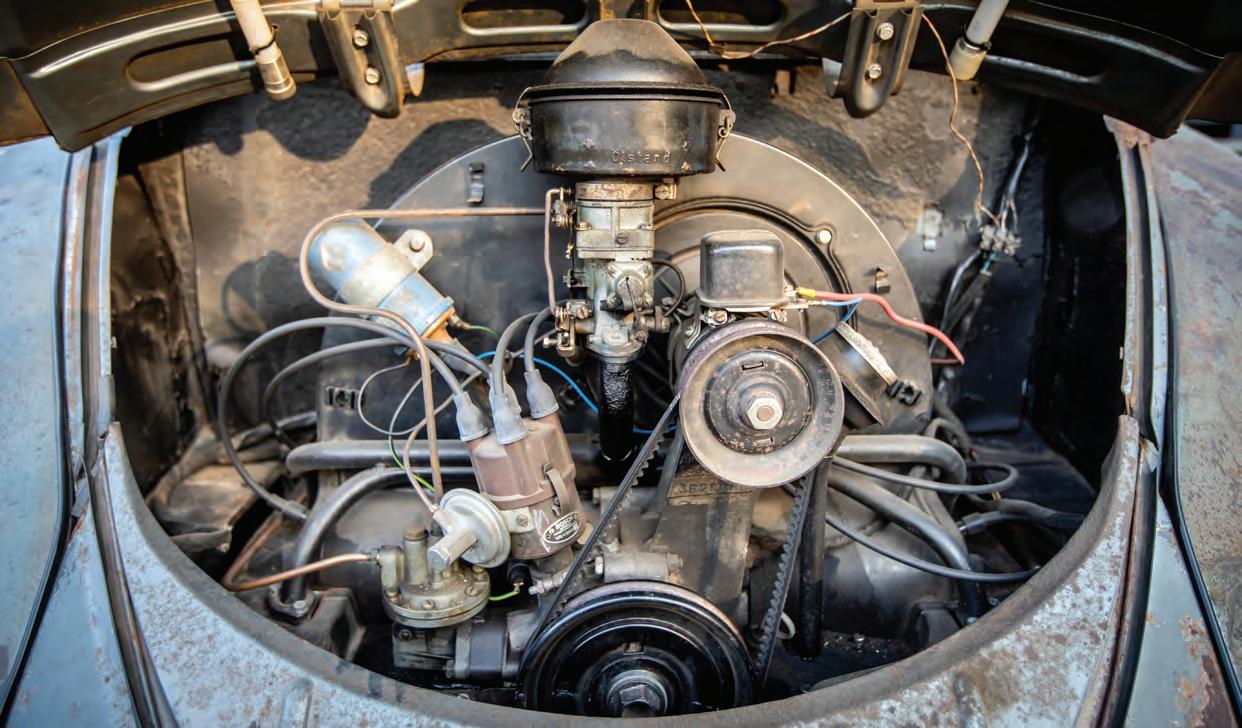

WANTTOADVERTISEHERE?PLEASEEMAILadvertising@hayburner.co.ukFORDETAILS







This is a feature about when a vehicle becomes much more than “just” a vehicle. This isn’t an A to B vehicle – nope, this one is the whole alphabet. It’s an honest and authentic bus –truly built for purpose.
This isn’t a vehicle with award-winning paint, or an award-winning interior, a race-spec engine or an electric conversion. This is something that, day by day, is becoming rarer and rarer in our community. This is an authentic, genuine camper van, a home – a mobile home even. Not just for weekends away in Cornwall over the summer months either. This is pretty much an all-year-round lifestyle choice for its owner, Chris Harper. Within our community, this sort

of usage has become a rarity. I can name hundreds of show vehicles, but how many vehicle/owner combos can you name that have racked up over 800 nights and 60,000 miles in their vehicle in just under a decade of ownership? I can’t name a single one…
Is this combo perhaps one of the most unique features to grace these hallowed pages? Well, once you look at it that way, I’d probably say, yes, it is.
So, let’s get started. Chris attests that his love of cars and car culture started at home, with his dad, the owner of a “one-man automotive body shop”. (Coincidental side note:
Chris’ dad painted my Beryl Green ’63 back in the day.) He has fond memories of attending events all over the UK with his family in their Celica show car.
It was only a matter of time before Chris would find a classic of his own. He had always had a soft spot for old Volkswagens, both Bugs and buses, as they always made him smile when he saw them out on the road. So, when the time came for Chris to find himself a classic project, he got himself a smart little 1969 Oz-import Bug – slammed, narrowed and tough looking. Although Chris was more than happy with the Bug, like many of us he had aspirations to own a camper. Whether it be the lure of the open road, not having to set up tents in the cold rain, or maybe the idea of home being where you park it – whatever the reason, sadly the “gateway” Bug would need to go.
With the ’69 now in his rear-view mirror, Chris set his sights

on a Bay Window bus, specifically a 1967–1972. He was looking for the earlier style of the second-generation transporter, with lower front indicators, smoother, rounder bumpers, split window-style rear lights and a generally pure and simple aesthetic. Something not too clean, not too perfect, but within budget and something he could put his mark on.
“Essentially, I bought the cheapest beige Early Bay I could find at the time …” Chris found a 1970 Deluxe model Early Bay, US spec, and the ideal blank canvas for what he had in mind. It ticked all his boxes.
The bus was located on the west coast of the USA, in Spokane, WA, and after the usual back and forth, a deal was done. However, at this









point the now-excited Chris had to exercise patience, as frustratingly things were delayed by a few months after a huge dump of snow had trapped the vehicle in storage and it wouldn’t be able to move until after the snow was clear.
Buying things off the internet always has its risks. You can ask all the right questions, look at the photos, but until the product is sat in front of you there is always the anxiety of “what have I really bought?” … “The bus arrived, and it was clear it had been multiple colours before, including metallic green. It’s had a bump on the nose and some filler here and there,” Chris says. He was satisfied, and this was all nothing out of the ordinary. He had found a good bus – solid enough with some basic work required, but all par for the course.
It wasn’t long before Chris got stuck in. Working on the vehicle almost entirely by himself, he was starting to become handy around the tools – which is key for life on the road with an old Volkswagen. He learned to weld, to repair and to paint (thanks to some help from Pops). “Having no huge budget, I had to learn how to weld, doing some inner and outer sill repairs after I had the bus shot-blasted underneath.” Chris fitted the bus with a 4-inch narrowed beam, with adjusters, choosing to retain stock spindles. The rear was slightly lowered on the torsion bars, with KYB






adjustable gas shocks on each corner. Chris chose to run original drum brakes, albeit rebuilt to a high standard with new components and powder-coated backing plates. These are paired up to stock 14-inch steels with a staggered offset and some vintage beauty rings. Not forgetting the “chonky” Maxxis Worm Drive 195/80/14 front and rear tyres, which suit the bus perfectly and take away any anxiety of getting stuck at the edge of a muddy field, bog, snow-capped mountain, beach or European campsite.
“One of my favourite touches is the square Deluxe side lights. From factory, the front is just a reflector and the rear lights are backlit. I found a set of genuine rear backing plates with bulb holders, drilled the holes needed for the bulb holder section in the front doors, and wired them all to a switch, so all four now light up.”
Powering the bus is a 1776cc motor from Rapid Rodent racing. This gives the bus plenty of pep for longer motorway journeys and plenty of torque for the steeper inclines. This is mated to a rebuilt “6-rib” gearbox with a Bug-Tech shifter.
With the mechanical elements out of the way, let’s turn our attention to the interior – a place where Chris has spent many a night on the road. Every single element of this interior has a purpose.
Let’s start at the front. The passenger seat was removed for additional storage for Chris’ water supply, work gear and boots. He doesn’t carry a passenger up front, so he chose to make use of every inch of space the bus offers, and built himself a custom storage system.
Moving back past the walkthrough, you have a cooking station and fridge system – a Tilley stove mounted onto a cabinet built (again) by Chris himself. The large drawer at the bottom houses a good-sized fridge surrounded by insulation.
Along the long panel, you have another hand-built cabinet for all of Chris’ other essentials – clothes, hygiene products, etc. As I said, every single part of this bus makes use of space, using many salvaged and reclaimed bits. Like the wood, for example: “Most of the interior is off-cuts from bins or friends.”
A 2/3 “rock n roll” bed with a trusty Mexican blanket

follows at the rear, and a fold-away table system sits centrally. A black headliner with LED lights is mounted throughout for decent light on those darker nights.
Chris takes a break from life on the road during the deep winter. The bus has no heating whatsoever, and although Chris makes do with thermal insulation, it gets to a point where, for his own health, he returns back to his folks’ place for a breather and to make necessary repairs. Everything in this space must be kept tidy and serve a purpose.
So, what is it like living in a Bay?
“Living in the Bay has its challenges, but I found it generally rewarding. Day to day, it’s a small space that requires everything to be kept in place, or it will be in the way or it will go flying whilst you’re on the road, so housekeeping is important. Space has to be used in multiple ways, so planning of the interior is important.




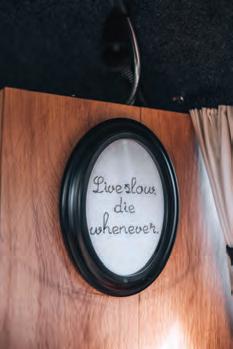




Mine slowly evolved the more I used it and came up with ideas around what is important and what just isn’t.”
Is “life on the road” what the internet makes it out to be?
“Life on the road isn’t what the influencers generally lead you to believe. It’s not just looking out the back door in crisp white bedding to a view worthy of a postcard. The powers in this country are making it harder day by day, slowly stopping the use of overnight parking facilities for any converted camper van or motorhome. I jump between being in a new place for a couple of weeks to a couple of months, so finding stuff like a regular shower, shopping, and most importantly a good place to park can be a hurdle at times. It’s rare when all three are perfect, but it’s great when they are. … I take convenience over beauty during the week Generally, the ‘big’ issues are staying on top of everything – like keeping a good supply of water and food, keeping clothes clean before you run out, shower/toilet use, and bus maintenance is vital if you’re not going to shy away from traveling hours on end week in, week out.”
How has the bus held up after all these miles?
“Generally, the bus has really looked after me and has been incredibly reliable. I was able to do a complete mechanical overhaul during Covid, which helped me learn every inch of the vehicle. Mostly, it’s been clutch and throttle cables (probably five throttle

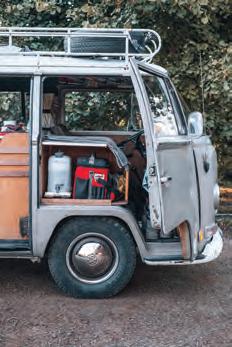




cables and three clutches), a couple of pairs of j-tubes, a couple of different electronic ignition systems, so I gave up and never looked back from points and condenser. A couple of push rod tube seals and multiple sliding door interior handles (from locking every night), but the big one was a repro front drum shearing the centre out earlier this summer. Thankfully, the damage was relatively minimal for a brake failure, but the sliding door still shows a scar. It could quite easily have been a sad story under different circumstances.”
Do you travel to many events?
“The longest trip was 2k miles in two weeks for the Barndoor Gathering and European Bug In in 2023, with the trip starting in St Austell and an unplanned extension due to one of the convoy having engine issues. The bus has also done two Hessisch trips, two Barndoor Gathering events, and Wanroij for Euro shows as well as multiple UK events.”
How do you summarise your life on the road?
“On the whole, it definitely has its challenges, but those challenges are also part of the fun. It can be rewarding, most certainly. It keeps you on your toes with planning ahead and keeping track of yourself and your rig. Importantly for me, it’s the freedom I’ve created for myself.
“One of the major positives is seeing with your own eyes that there are still good people out there who will help a stranded stranger in an old bus. For example, after shearing the drum, I found Beetle Magic only 15 minutes away. Olly and Ben really helped get me back on the road. Being far from ‘home’ and finding those guys was amazing. Ben kindly dropped me off another drum late at night, which got me to their workshop. I could then assess the rest of the damage, and they let me use their yard space when I needed it, and any tool I needed to keep me on the road. For their kindness, I am forever grateful.”
Ultimately, for Chris, this bus has given him memories he will cherish for a lifetime, with people he will never forget. It

has allowed him to go where the work is (Chris is a specialist plant machine operator) and yet he always feels at home…
Special thanks from Chris:
“I want to thank all of the friends I have made in the community. To the people I see once a year, if I’m lucky, or spend thousands of miles travelling in Europe with. I’ve had loads of amazing trips with close friends and love making new ones along the way. I’d like to thank my family, of course. I was entirely out of my depth at the beginning. Their support really helped me achieve my dream and goals with this bus. Dad especially!
“Tony Hawk himself (Paul Wisk) and in the earlier days, Liam ‘Epic’ Penny plus the rest of the gang. Those guys really helped steer me in the right direction and most importantly, helped to keep me on the road. Karl Stevens (workshop neighbour) for all the technical help and laughs over the years. Karl is a hero when it comes to doing the best you can with what you have. Especially in campaigning his hill climb and track cars.”
Engine information: 1776cc
Autolinea case
Engle 100 cam

Twin Weber ICT carburettors
CSP linkage
Uprated oil pump with external filter
Powder-coated Tinware
Polished Malpassi fuel regulator
K&N filters both air and oil.
NGK plugs
Mocal braided hose

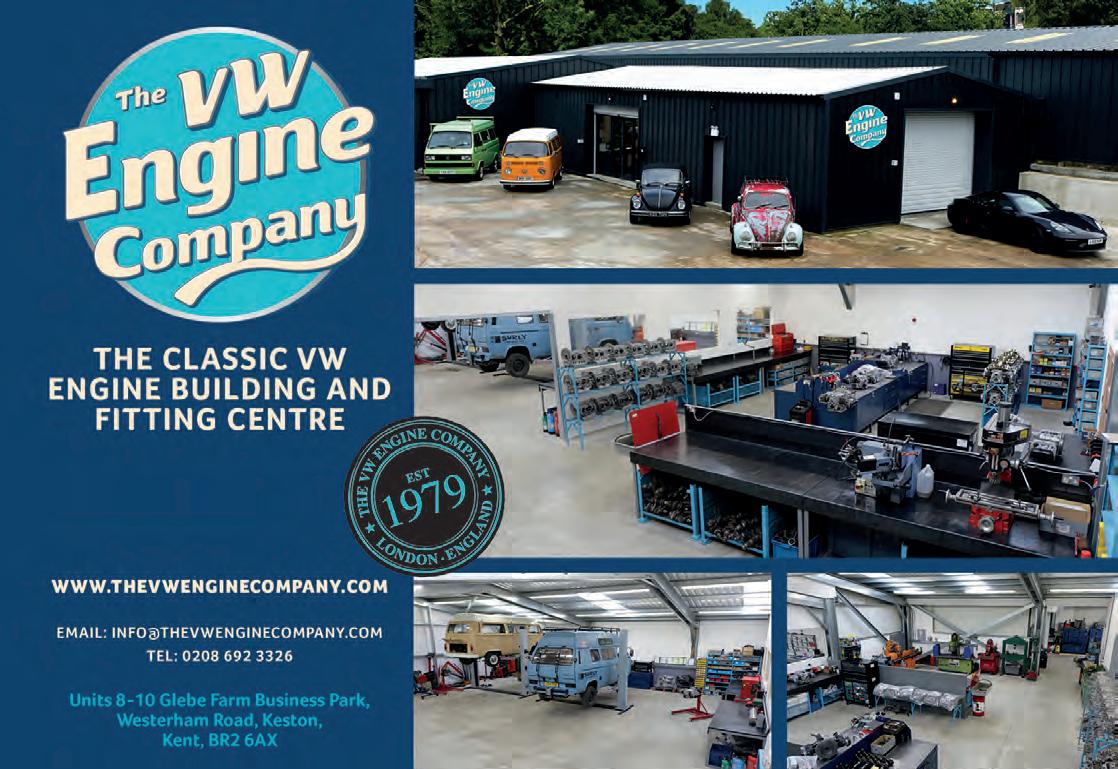




WANTTOADVERTISEHERE?PLEASEEMAILadvertising@hayburner.co.ukFORDETAILS




WANTTOADVERTISEHERE?PLEASEEMAILadvertising@hayburner.co.ukFORDETAILS



Words by Vic Faux
- Chris De La Marche / Other photos - Nell Baker
It’s not every day that I, among all the team at Hayburner HQ, volunteer to write an article about Brazilian VWs. That honour usually goes to Dan, our resident South American VW enthusiast, who has a deep fascination with these quirky German relatives. So, what prompted me to take on this particular car? Our motto here in the office – OK, let’s go…
Earlier this year, I had the privilege of travelling to Brazil thanks to our good friend Bob from B.B.T., however, I felt that our final day of the trip deserved its own spot in the magazine as it was a very special one indeed. When the chance arose to write about this amazing Bianco S you see on the next few pages, I couldn’t resist the idea of merging everything I had experienced into a comprehensive article on this remarkable yet lesser-known vehicle, with its own significant and unique Brazilian history.

Spoiler alert – Bob, Nell and I actually met the designer, creator and visionary of this incredible model of car – Ottorino (Toni) Bianco. This was such a privilege as we were invited into his home, met his family, looked through their personal archives and even got to sit in his own private example. It was a great day, but I will get on to that once I tell you a little bit of the history behind these vehicles and why they stood out for me.
Toni was born in Italy on 8 January 1931 and emigrated to Brazil in 1952. I honestly had no
idea that he was 93; he was so active – getting involved in all manner of conversations (even the ones that were spoken in English which were untranslatable!). After a brief stint in the Brazilian countryside he relocated to São Paulo in 1954, where he began working in the workshop of fellow Italian Oliviero Monarca. There, he contributed to the construction of custom car bodies, reminiscent of the work done by Zagato or Bertone over in his motherland.
His mechanical talent quickly gained recognition,

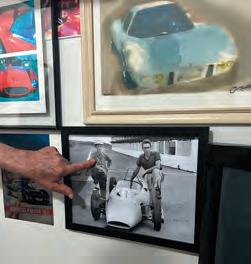


A slight rewind here to why there was such a desire in Brazil for any type of heritage sports cars or the like. From 1947 to 1952, the Brazilian government took action intending to restrict imports of motor vehicles and auto parts. As a result, it invested more in the Brazilian automotive industry than in importing oil or wheat. So, by the time of 1953’s ban on importing fully manufactured autos, Volkswagen, Mercedes-Benz and Willys-Overland already had fully working and established factories in Brazil. It seems that Toni was in the right place at the right time to create
and in 1957 Toni was invited to join the workshop of the Italian duo Nicola and Victor Losacco, who specialised in preparing vehicles for competition. During his time there, he designed tubular chassis and assembled cars for national competitions using imported engines. These tubular designs can be seen throughout the archive photos and the miniatures that were on show in Toni’s home; he began each project in miniature before bringing them to life on a larger scale.
A few years later, in 1959, Toni created Brazil’s first Formula Junior car, featuring his own chassis, a Porsche 1.5L engine and a Volkswagen front suspension. Among those who drove these racing cars was a young Emerson Fittipaldi, also of Italian descent, who would later become a world-renowned Formula 1 driver.


something that he was obviously focused on creating, and there was definitely a fresh Brazilian market waiting to see what he came up with. And boy, did he deliver!
Throughout the 1960s, together with another Italian racing driver “Chico Landi”, Toni Bianco created the “Industria de Automoveis Brasil” and started producing the Formula Junior, but this time there was little choice but to do it with Brazilian engines. By 1965 he joined the competition department at Willys (an American


automobile company) , where he focused intensively on racing car development. The story truly took off at the end of 1969 when the Willys competition department was shut down. Toni then partnered with FNM, the major Brazilian car manufacturing factory in São Paulo, and founded “Furia Auto Esporte Ltda”. Here he developed the Furia sports prototypes, inspired by a design from the mid-1960s by Carrozzeria Fissore. He later designed and built the “Furia GT” at the request of FNM.
This collaboration lasted until 1974, when Toni established his own company, “Toni Bianco Competições”. After years of manufacturing racing cars, he dreamed of launching a street version of the Furia racing models – echoing the story of Enzo Ferrari, who transitioned from racing to producing high-end sports cars. While Bianco’s journey was on a much smaller scale and Brazil was not quite Italy, his visions were ambitious.
It is essential to highlight here the significance of the Volkswagen Beetle in Brazil. From the moment we landed and hit the roads in this amazing country, it became clear just
how deeply the “fusca” (Beetle) is embedded into everyday Brazilian life and culture even today. Several factors contribute to its importance in the past: import restrictions, the demand for affordable and reliable vehicles, government investment in VW factories, and the cultural significance of what the car represented to the nation. Given these factors, it’s no wonder Toni Bianco saw the potential of creating a sports car using the Beetle chassis. The combination of cultural relevance, affordability and local manufacturing made the fusca a perfect foundation for an innovative design.
By early 1975 the first of Toni’s prototype cars were undergoing testing, and in 1976 he unveiled the “Bianco Furia S” at the Brazilian National Motor Show. This two-seater coupe featured striking aerodynamic lines inspired by the 1969 Furia racing cars and stood just 116cm tall. With its sleek design and “fast” aesthetics it is no surprise that the vehicle was a hit at the show, with 180 units selling immediately. The body was constructed from a blend of fibreglass and plastic, mounted on a Volkswagen Brasília chassis and powered by a 1600cc VW engine with dual carburettors. In addition, it brought electric windows, leather interior trim and a laminated green windshield with

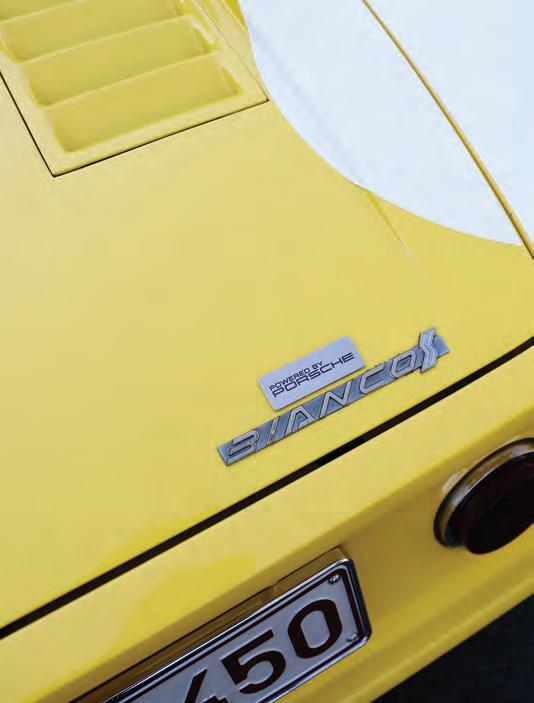
built-in antenna (for the first time in Brazil). In total, around 320 units were said to have been produced. Prominent models were the Bianco S, the Bianco 2 Series and the Bianco Tarpan, with the Bianco S seeing the highest production figures.
The Bianco Furia S2, a 1977 version, featured several updates: no cooling fins in the front lid, without cooling vents in the rear hood, and with rubber bumpers on the front and rear spoiler. Unfortunately, the company faced bankruptcy in 1979 but Toni Bianco didn’t stop there. He was often seen, as late as 2018, still tinkering at his all-time family home, in the same place in São Paulo (where we met Toni and his family).
It was clear to see the immense pride that Toni and his family held for the legacy he built throughout his career. His daughter clutched a homemade archive book tightly during our entire visit, eagerly sharing


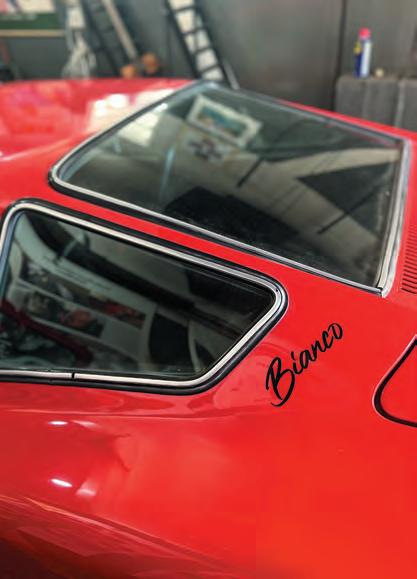

various clippings, articles and photographs that chronicled the Bianco dynasty. The experience was genuinely emotional, and within just that hour it was evident how deeply proud they were of Toni. I felt truly honoured to meet such an extraordinary individual and it is something that will stay with me for years to come.
With the history lesson behind us, let’s turn our attention to the Bianco that your fortunate eyes will encounter in the pages ahead...

Often mistaken for the fashion icon with a similar name, Guy Verschatse is a 60-year-old entrepreneur from Oudenaarde, East Flanders, Belgium. Despite recently celebrating his milestone birthday he feels as youthful as ever. Alongside his wife Katrien, Guy runs a prominent dog sport equipment company, K9-K4, and owns several other companies. Yet it’s not just business that fuels his passion: it’s a love for classic cars, particularly this rare find from Brazil.

Guy’s journey into the world of vintage vehicles began just seven years ago with a Lotus Super 7. Following that, he ventured into the realm of air-cooled Porsches, drawn by their efficiency and simplicity. Despite his appreciation for classic cars, he admits, “I’m not a big fan of Beetles”. Instead, it was the Brazilian Puma that caught his eye, which led him to finding out about the Bianco Furia S – which then ultimately led Guy to buy one for himself, and I really do not blame him one bit.




Finding the right Bianco was no easy task. Over two years, Guy encountered numerous advertisements, only to be disappointed time and again. Most of the cars on offer were either wrecks or had been poorly modified. After reaching out to various Brazilian online groups, his luck finally changed. A friendly aeroplane pilot, who was managing the sale of a wealthy collector’s estate, contacted Guy. The collector owned around 60 cars, and
among them was this elusive Bianco Furia S.
This first-series model, built in 1976, had been tucked away in a dry building for over 20 years. With just 22,000km on the odometer, it was in a remarkably original condition, although age had taken its toll on various rubber components. Guy’s discerning eye for quality assured him that, despite the necessary repairs, the car’s body and chassis were free

of rust and, with all fingers crossed, was going to be the solid car he was hoping for.
Drawn to the Bianco’s vibrant racing yellow paint, Guy proceeded on a vigorous restoration process, enlisting skilled friends, tackling some aspects himself, and hiring in some professional help for the important bits. The latter included the car’s electrical system which was a significant challenge, leading to the

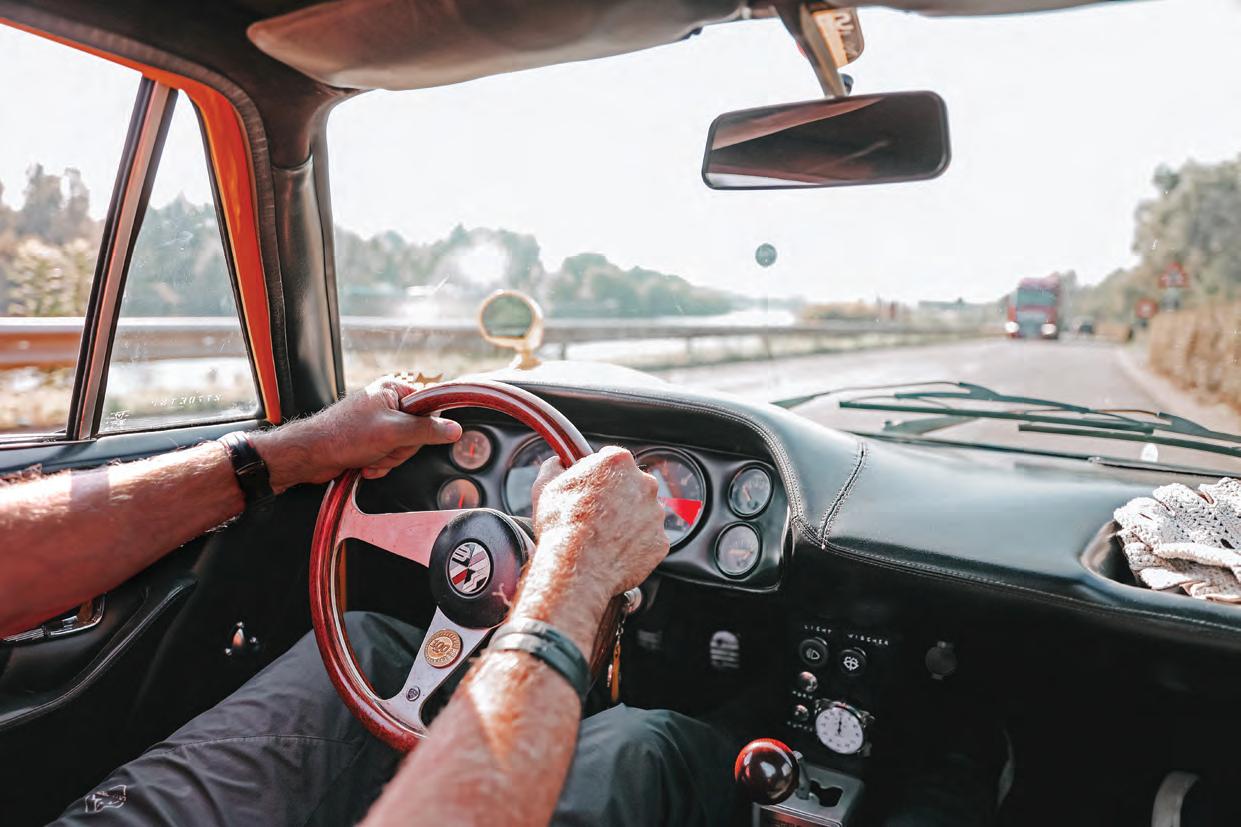
replacement of the entire loom with a standard Beetle loom, modified slightly to fit. The original interior was not up to par either, prompting Guy to hand-restore it, aiming at the stylish aesthetics of 1960s Italian supercars and inspired by this era’s sleek design. So he backdated the interior to give it a more vintage race car feel, while adhering to the higher Western standards of detail and quality. Although the dashboard was in great shape due to its sheltered life, the original seats posed a problem; they were too high for his height, forcing him to duck under the roof. To solve this, he imported two slim Speedwell Racing seats from the UK, ensuring a roomier and perfect fit. Additionally, he added and repaired the carpet after removing an overly bulky console.
The engine was in good health thanks to its low mileage. Guy replaced the entire ignition system and upgraded to a stainless racing manifold, crafting a custom muffler inspired by Porsche designs. Knecht air filters and a bypass Fram 356 oil filter were also added, along with copper gas pipes for that authentic Okrasa look.
Guy expresses his heartfelt gratitude to his wife, Katrien, for supporting all his motoring adventures, and to his friends Davy and Stijn for their expertise with the paint and electrical work. With the Bianco now restored to its former glory, Guy is eager to share his passion for classic cars with his friends and perhaps even participate in some vintage car events across Europe. We hope to see you at Le Bug Show 2025, so we can see the car in all its glory!













Restoring aircooled VWs since 2001
Servicing, inspections and MOT’s
Lowering and mechanical upgrades
Modification and fabrication
Auto electrics, split charge systems and 240 volt hook-ups
For all air-cooled VW’s and transporter generations
Vehicle valuations
Call for FREE friendly advice






PHOTOS BY SI MEDLICOTT
When Ned told me which vehicle I was going to write about for this issue, I was super stoked. I know I often say this, but when I was just a little snotty VW freak starting out, a lot of the vehicles I now have the privilege of writing about were vehicles that opened my eyes to how cool classic VWs and the people really were. If you had told me back then that I would one day be writing for the UK’s best VW publication about them I would never have believed you.
This is a vehicle I’ve known for years. Over time as I became friends with Rikki, we spent many an evening at shows chewing the fat and having a beer with friends in this bus. Considering that Barndoors were pretty scarce back then and that this bus was Rikki’s pride and joy, it amazes me that he welcomed everyone in to enjoy it and was never over-precious about it, sometimes just wandering off leaving everyone sitting in there
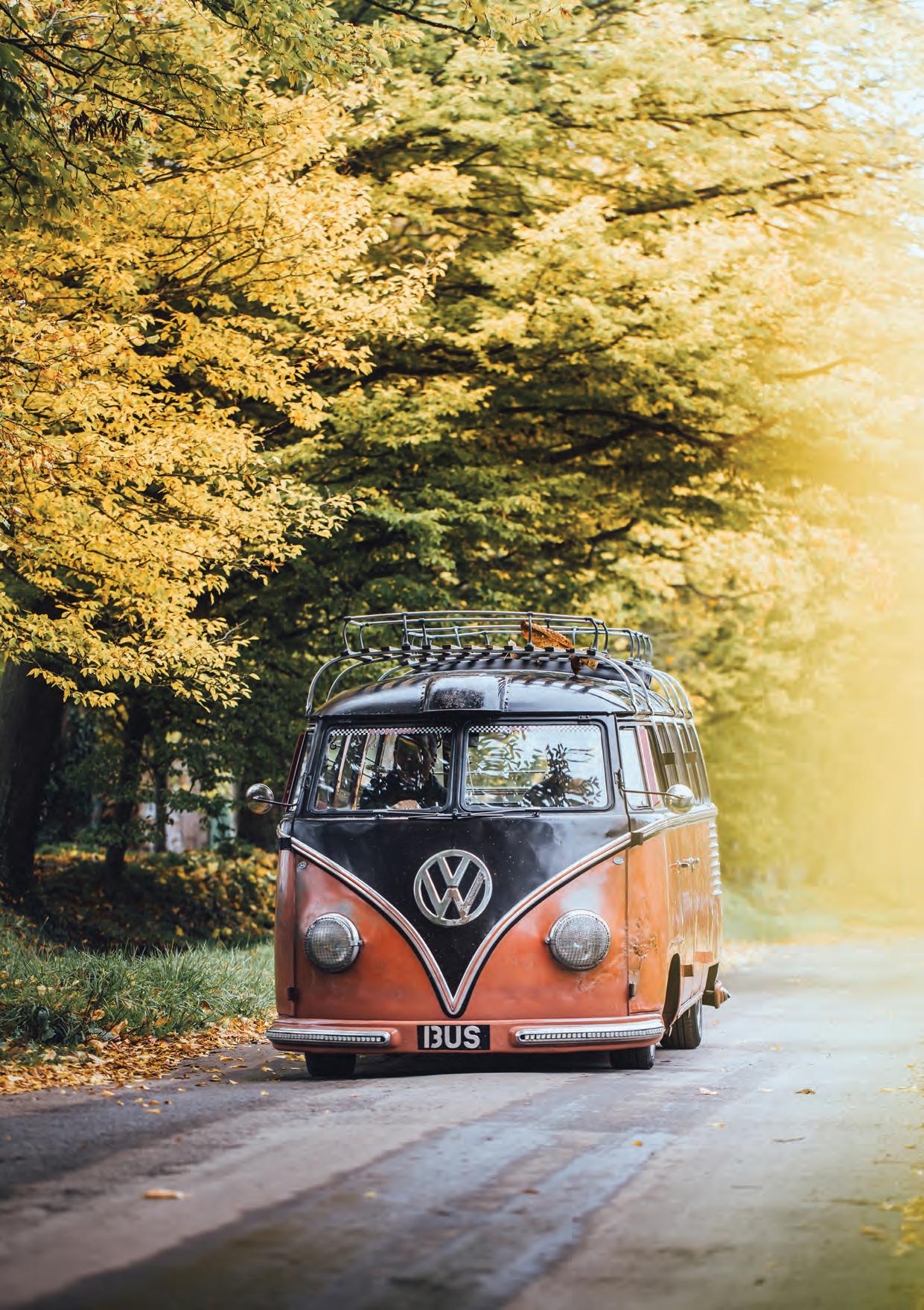
carrying on with their evening. This reflects Rikki’s character – always smiling, always happy and eager to help anyone out, a true “VW guy”. I can’t believe this bus hasn’t been featured before, for a number of reasons. The first, is that this bus, although it doesn’t get around as much as it used to, would be seen at almost every event we went to all over the country in the late nineties and early noughties. Unusually for me, that didn’t bother me, as it’s such an awesome bus to look at and around, and it was great to see its evolution. Back then, right-hand drive ’54 Barndoor Sambas were not particularly common, and this bus played host to a number of firsts in the UK VW scene in the 1990s. We will touch on them later.
The other reason is that I’d argue that almost everybody who has been into air-cooled VWs for over a year knows who Rikki James is or has heard of him. If you are in the smaller minority,


Rikki is a super-friendly and enthusiastic VW aficionado who has been a name synonymous with VW Type 2’s or to be more precise Splitscreens for around 30 years – truly part of the fabric of the UK VW scene. A long-term member of the SSVC with the specific role of Special Displays, Rikki has created some very impressive line-ups of Type2s over the years. I’m sure you will all be aware of the SSVC convoys to Stanford Hall from the AGM at Victoria Farm back in the day. They were absolutely immense.
Having been a prominent figure in the VW community for a good few decades, we wanted to learn how it all started for Rikki.
Rikki’s father was in his day one of the best ploughmen in the country. He was pretty much the most decorated person on the national ploughing match circuit (yes, this is a thing). He was gifted when it came to ploughing with a tractor but even better with a pair of carthorses and a single furrowed plough. Eventually becoming a judge meant no more hauling tractors and ploughs around the country. Instead, Rikki and the family would jump into his dad’s Ford Zephyr 6 with Sprite Musketeer caravan on tow. This soon became an issue as the car would get stuck in muddy fields. Eventually came those fateful words that sparked Rikki’s lifelong passion: “That’s it. I’m going to buy a camper van.” From that day onwards everything would change. Enter a 1963 pop-top Dormobile. Rikki was excited that his “new bed” was up in the roof. When you’re a kid all this is a big deal so, as they say, the seeds were sown!
Twenty years later, Rikki was living in West London and thought it would be a good idea to buy a camper van in order to get away at the weekends. Conveniently, there just so happened to be a rather nice 1965 right-hand drive Westy parked up on Ladbroke Road, so a message was left on the windscreen. About a month later Rikki received a call from the



owner and, to cut a long story short, the bus was his a few weeks later
While tidying up the interior, Rikki found an old Splitscreen Van Club newsletter/magazine. Back then it was a photocopied black and white zine, hand-stapled and even with some information handwritten.



He decided to join the club as there were some great contacts for parts as well as listings for SSVC campouts. Back then, you have to remember, there was no internet, so all communications were via magazine or landline phone calls. Rikki joined the club in 1989 and in the first newsletter he received he remembers an advertisement for a campout event in the New Forest. “I decided to attend the event and got pretty excited as the date drew near. I remember arriving late due to work and traffic, etc. In fact it was dark when we







arrived. However, I could just about see that there were 12 Splitscreen buses parked up and everyone was asleep! The next morning, I was up the crack of dawn investigating all the buses. Most of the members were in Panel Vans and Kombis. However, on Saturday afternoon a blue and white 21-window Samba rolled in and totally blew my mind. I instantly knew I had to have one.”
A couple of months after the event, Rikki spotted a rough, right-hand drive 21-window Samba with a Devon interior for sale in the SSVC newsletter. He drove down to Steyning, north of Worthing, in his Westy to view it.


The guy selling it was gobsmacked when Rikki said, “I don’t have any money but how would you like to just swap buses?” The guy agreed, so logbooks were exchanged and the deal was done! The bus was known on the VW scene as the Banana Bus. Rikki drove around Europe in this bus, covering 10,000 miles in six months. After that he bought a 1965 21-window Samba which was sold quite quickly as somebody really wanted it. After that came a 1960 right-hand drive Devon. The next bus after that was a 1958 right-hand drive 23-window Samba which was an awesome bus – disc brakes up front, straight

axles and a 1835cc motor. You’re now probably beginning to see a trend here.
In 1996 Rikki had the opportunity to purchase the 1954 right-hand drive Barndoor Samba you can see on these pages or, as far as Rikki was concerned, “the Holy Grail of buses”. This bus was found in Sweden. It had been sat in woodlands for who knows how long and was slightly the worse for wear. This was 28 years ago and it was not the standard flatpack-style Swedish fare we are used to seeing nowadays – the gearbox was shot, the engine was missing, the brakes were seized, but most of the accessories and hard-to-find parts were still with the bus. Also, most of the original paint was still intact which was a massive bonus. From day one Rikki knew this was the bus for him and he knew the direction in terms of its restoration.

You have to bear in mind that when this bus was built back in 1996 there were very few offthe-shelf parts available to match what was in Rikki’s head and how he wanted the bus to look and perform. Rikki was on the committee of the Splitscreen Van Club at this time with the role of Special Displays, which meant getting Split bus owners to display their buses in club line-ups at as many VW shows as possible. Quite often this would mean two shows in one weekend, driving from one side of the country to the other, so there was no way he was interested in attempting this with a standard 30 bhp engine and gearbox.
Rikki’s first mission was to address this. A nice reliable stock 1600 single port or something

would be most people’s go-to to munch up the miles reliably, but Rikki had other ideas. He sourced an outrageous 2.6 monster engine that had been in a 914 imported from California, which was making roughly 200bhp at the flywheel! The cylinder heads are a work of art with enormous porting – so big that extra material had to be added to the manifolds to match up. The 48 IDAs feed the beast, with those super-cool elongated velocity stacks inspired by some of the trans-American ’70s race cars seen at the Goodwood Revival. All internals are pretty much one-offs and were the best available back in the day. The upright carbon fan shroud was probably the first of its kind in a bus in the UK at that time and changed the look of the engine big time. To help it breathe and keep cool there is an oil expansion tank plus large secondary sump and external oil
cooler with thermostatic fan. The gearbox is kind of a one-off too. It started life as a Porsche 915 nonhydraulic, non-dogleg 1st gear, 5-speed unit, and has been modified and rebuilt with a taller 5th gear for cruising and brackets welded to the actual box for mounting to the chassis. The engine and gearbox are mated together via an 8mm motor plate which is also connected to the chassis. This meant having to use a long-reach Wasp starter motor – a learning curve as it destroyed many standard units. The drive shafts were also one-off shortened shafts. The clutch plate again is a one-off daisy unit made up of a metal carbon composite, and the gear selection rods have been replaced with a cable system.
This bus was designed for speed. The powerful engine and 5-speed box have achieved everything that Rikki

desired. When driving sensibly (60mph), the bus will return 30–40 miles to the gallon. In anger (80 mph and some), 10mpg can be the average return. Rikki says: “When the bus is consuming this amount of fuel it’s totally worth it as the symphony it produces is incredible. Just to give an indication of what the bus is capable of, when driving at warp factor 10 (on the autobahn), you can change gear from 4th to 5th at about 80 mph, and instantly it ‘comes on cam’ and all hell breaks loose. It is well capable of hitting 120mph plus! Interestingly, the higher the speed the more


stable it feels, which is just as well as I like to use its capabilities. The bus runs late 15, early 16 second, quarter-mile passes on the drag strip, which isn’t bad as it wasn’t really designed for this purpose. It was also a lot of fun on the Goodwood Circuit even if a bit of a handful on some of the corners and chicane. It’s mostly at home on the motorways where it ‘owns’ the outside lanes.”
With all this power, the stopping power needs to be addressed. Again, when Rikki built the bus there




were no off-the-shelf kits available, so the brake system was made up of Porsche 911 discs on all four corners, Golf GTI callipers and pads with a Late Bay servo, which works a treat.
The front beam is the original Barndoor unit, narrowed by 5 inches with adjusters and drop spindles added. Again this was the first Split bus to have this done in the UK and probably the world. The rear suspension had been narrowed and IRS’ed with the addition of adjustable spring plates which is a must in order to


get the desired stance and ride. A lot of pioneering modifications were performed on this bus a long time before it became “the norm”, but Rikki accomplished the look and the performance he had envisioned.
The ’54 made its debut at the SSVC’s AGM held at Stratford-upon-Avon Racecourse. It was by no means finished. As mentioned above, mechanically it was complete, but the rest of the bus was untouched. At the time of the AGM Rikki had literally
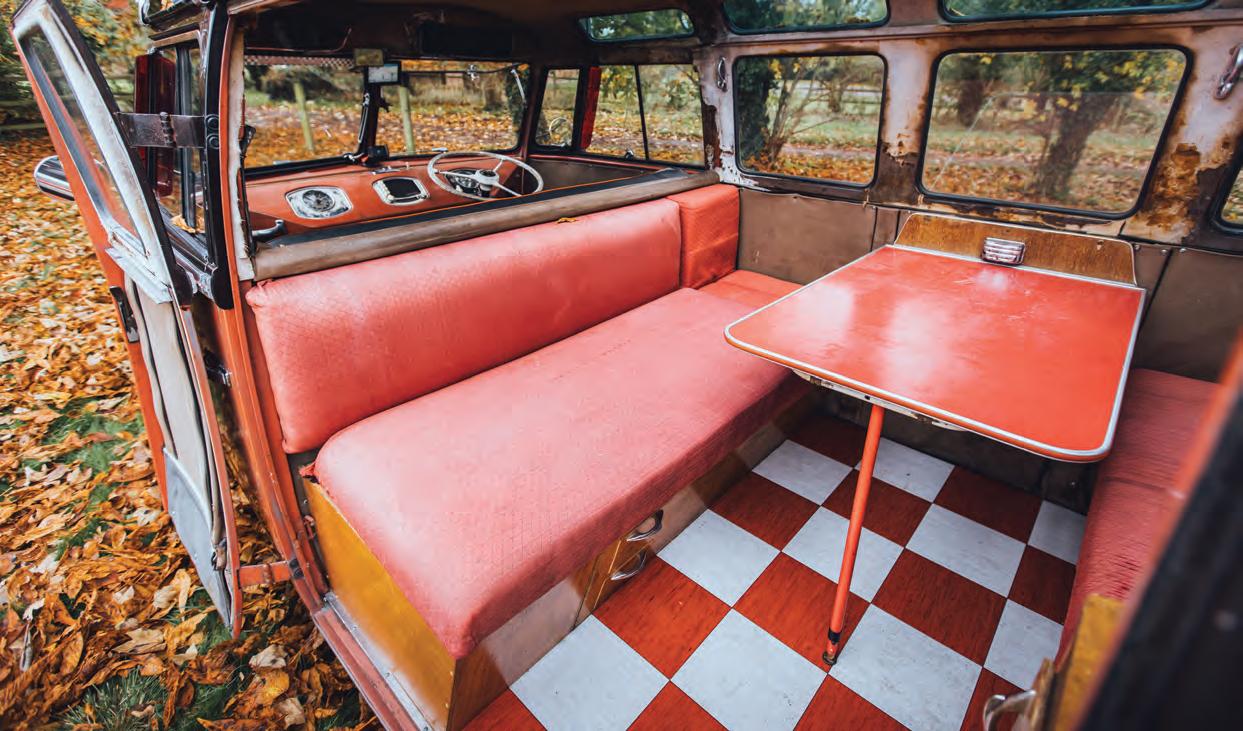

picked it up from Southend-onSea and driven it straight to the AGM with no interior whatsoever: no door cards, seats, sunroof inner or outer covers, headlinings, etc. – just a cheap blow-up beach lilo. You’ve guessed it – in the middle of the night it rained so Rikki had to move his bus into the marquee!
This prompted a search for a camping interior, which eventually came out of a left-hand drive
Swedish Barndoor with loading doors on the left. This is a weird Swedish-spec-only thing, which is just as well as the period interior slotted into Rikki’s bus perfectly. The interior has been modified over the years several times, trying to get the best out of it, and only recently Rikki built a rear overhead cupboard unit out of the spare bits that he’d kept for many years and never used. The bus is more refined now than it’s ever been. The most recent installation


was the gas night heater which is pure heaven when camping early and late season.
Rikki has accumulated some amazing accessories and parts for the bus over almost 30 years of ownership. Early parts and accessories are getting increasingly hard to find and super expensive if you do find them. Some of Rikki’s favourites include: the Telefunken valve radio in the centre of the dash,



bought for £300 at Bad Camberg in the late ’90s; the correct matching digital clock (the face, needle and carcass of the clock are all original and the internals digital – a neat trick) and nos speedo in mph; the set of five super light, original American Racing Torq Thrust D wheels; the rare Behr air scoop; the matching Westy roof racks; aluminium Barndoor-only safari window including invisible wiper disengagers and triple blade wipers (three actual blades); the super-rare red side window wind deflectors; the rear Hella number plate light accessory; the commemorative end of Samba production VW logo centre mount for the rear jail bars (which incidentally were all recalled apart from three by the dealership because of poor castings!); the Porsche 356 light lenses protectors; the adjustable/hand tightening mirror fixings; and last but not least the magnificent Chinese front bumper trim lights.
Now how about that super cool number plate? I remember when Rikki added this. He tells us: “It was a total surprise when my mother left me a small inheritance when she passed away. It was just enough to purchase the plate which I had been trying to buy for decades. With her assistance this was made possible and it reminds me every time I see it just how awesome she was.”
Rikki reminded us the bus has just turned 70 years old. He drives it on a daily basis if he can and still uses it for the occasional family holiday. The only time it doesn’t get driven is when the roads have been salted or it’s just too cold! He loves driving it, he loves camping in it, and for him that’s what it’s all about. In fact that’s what it’s all about for all of us – a little reminder that we are all in this together, one of the best car communities in the world.










WORDS BY CHEZ WILLIAMS



So it’s Monday morning and I’m sat looking around my workshop. Saturday was my 50th birthday and I have had a lot of time to think about life, the universe and everything. I’m certainly not getting any younger and the world is definitely getting more complicated. In April, Rapid Rodent Racing will have been trading from the same unit we are in now for 15 years. During that time many things have changed. We saw some very good times in the earlier years which I always look back on with fond memories. Brexit did us no good whatsoever, and then Covid was another kick in the teeth for small businesses. To top it all off, I got an email from my accountant telling me that from April I need to do four tax



returns every year instead of one, and pay any tax that is expected before I even earn it. This seems quite crazy to me, and with the recent Labour government and their batshit bonkers budget I’m feeling that things are getting quite tough.
After 15 years of paying rent on the unit, wages for staff, business rates, insurance for everything in the workshop and cars in the yard, insurance to drive and a constant snap on bill, I’m a bit worn out by it all, if I’m honest. It’s time to think about the future and how it looks as far as small business survival is concerned. The cost of almost everything has gone up so much and so fast that it’s been a fulltime job just keeping up with it all.

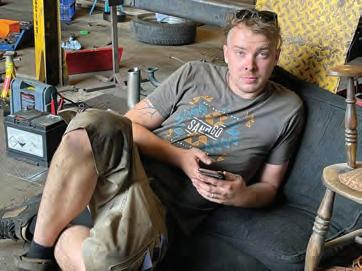

I genuinely think this country is becoming a tough place to make a living as a small entity in a big world.
Having worked all my life since I was 16, the last 15 years of that being self-employed have been the most enjoyable by far. It’s been a big learning curve trying to wrap my head around running a company as I had never done it before. I have learnt a lot of lessons along the way and would never want to put anyone off working for themselves. That being said, I think it’s time for me to go and do some of the things I have always wanted to do but not been able to due to commitments here.
Back in north Wales, mum and




dad still live on the family farm where I grew up. They are getting older, as we all are, and I realise that they will need more help in the future. This gives me a small window of opportunity to go travelling. I currently don’t have a dog or a house that I own or any real ties to worry about, so I guess now is the time. If I don’t do it in the next few years I may well miss my opportunity and I think that is something I would regret. The world is a very big place and I have not seen anywhere near enough of it. That needs to change.
Looking around my workshop and yard, it’s obvious that I have a lot to do before I pack up – lots of cars and parts to get rid of and still a fair bit of work in the yard




that needs doing. I have set myself a goal of having it all sorted within two years, but if I’m honest I would like that to be closer to one year if that’s possible. I spoke to Loz this morning, who has now worked with me for over seven years, and asked him if he would be interested in taking over. He has an eight-month-old and a lot on his plate, so needs some time to think about it all. I have 15 years of straight books and a good accountant who has kept me in line over the years. Maybe someone will want to make me an offer to take over the place as it is, or maybe I will just sell everything and travel on the money. I can’t say I know exactly how this will all work out but I do know it’s time to roll the dice.




I am genuinely terrified, writing all this down, as it’s all been random thoughts in my head so far and now it feels very real. Even though it’s scary, I almost feel a weight being taken off my shoulders already, which in my mind is a sign that I’m doing the right thing. Only time will tell if this is the right direction to go in, but it’s clear to me that things are changing and if I don’t change with them I will be left behind. It’s not that I have lost my love for the work I do; it’s more that I have lost the love for running my own business as things have got more challenging.
All of a sudden I do regret hoarding as much stuff as I have, but the other side of this coin is
that I have a lot of stuff to sell to fund my adventures. It’s odd getting my head into the mindset of selling rather than hoarding, but I’m sure the more I do the easier it will become. I feel very much like I’m spinning the wheel of destiny and have no idea where it will stop. I have been very lucky to have had good customers and always plenty of work. The support of Hayburner and my friends has really meant the world to me over the years and I don’t think I could have managed it without the kindness I have been shown. I think getting over the illness I had years ago made me realise that we really do only have one shot at this life and making the most of it is




So, in conclusion to my ramblings, it’s time to end one chapter and start a new one. I know this is not going to happen overnight and the workshop will still be busy for well over a year. I hope Loz takes it on if it’s right for him and his situation. Or maybe someone else will – who knows? I’m going to start putting things up for sale and scaling down the sort of work I’m taking on – no more big projects but plenty of small jobs while I get my ducks in a row. Not that I’m any good at duck management (yes, some of my ducks may well be pigeons), but I will give it my best shot.




Thanks to everyone who has been part of Rapid Rodent Racing –employees past and present, customers and supporters of every kind, and thanks to Ned and Vic for letting me contribute my random thoughts to their wonderful magazine. Writing the 50-odd articles I have done really has been like some kind of random therapy for me and has been massively enjoyable.
So here’s to a bright future for everyone and to new adventures. Now to get rid of my birthday hangover.

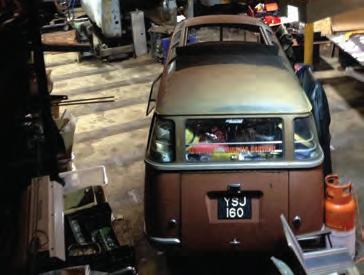







WANTTOADVERTISEHERE?PLEASEEMAILadvertising@hayburner.co.ukFORDETAILS





WANTTOADVERTISEHERE?PLEASEEMAILadvertising@hayburner.co.ukFORDETAILS





MORRISSEY
To quote Tyrion Lannister, “I have a special place in my heart for cripples, bastards and broken things.” So do I. The man meant that literally and I only mean it figuratively. I like things that are bit off the wall, a bit different – something that might not be to everyone’s taste. Bonkers fibreglass kit cars, 80s cars, custom cars and anything that’s just a bit odd, I love it. But on the back of that I also like subtlety, understated and well pulled off. Which is a

hard thing to get all together. This bus is ticking all of those boxes.
What we are looking at here is the brainchild of owner Allun Tugwell and product of the hands of Jamie Franklin. Jamie, for those that don’t know him, runs JF Bodyworks in Banbury, a bodyshop specialising in body and paint work for classic Volkswagens. When Allun found Jamie to talk
about a custom resto job on his Bay Window he had definitely gone to the right place. Jamie is no stranger to custom things. He’s built several custom buses over the years and his latest one was actually on the cover of Issue 49. But what is “custom”? Strictly speaking, any kind of change that isn’t original, or as intended, is custom. The image that most people think of when they hear custom will be the roof chops and extreme body mods of the late
80s and 90s, but it’s little more nuanced than that. If you take a look at the covers of VW Trends magazine from the mid- to late 80s, for example, you can see a very clear trend when “custom” started gaining in popularity. Body mods like roof chops and smoothing things like door handles and trim became a staple, and then on to non-stock paint jobs, and more extreme colours and graphics started seeping in. Coincidentally it is also when the



VW scene in the UK started to become a big thing.
The year 1987 saw the birth of a show in the UK that almost everyone with a classic VW has heard of and perhaps even been to – Bug Jam. There were shows in the UK at the time and an already established classic VW fan base, but Bug Jam brought something new. It was very much a west coast US-style show and these American-style cars were naturally






becoming a source of inspiration. This in turn attracted a younger crowd. Picture the late 80s in your head, or what you think of if you aren’t old enough to remember it. It was a time of boldness. Everything from massive haircuts to advertising was all bold and out there. This was the world that the young guys at the time grew up with and they wanted their cars the same way. Beetles were cheap, plentiful, easy to customise. They were the perfect playground for the skate and surf culture-inspired



80s kids. The next ten years would see the custom scene go crazy. There are some famous cars still around today that were built in this period. There is even a group called “Back to 89” which I’m sure most people will have heard of. They want to preserve this early time in UK Volkswagen history and most importantly the show cars from it. But, just as rapidly as the scene changed in the 80s, it would change again in the 90s. New styles arrived – again an import from the west coast of the USA –
styles referred to as Vintage Cal Look and Resto Cal. Vintage Cal referred to the original Cal-look cars of the 70s, and both included very little in the way of custom body mods. Original paint colours became fashionable again along with VW-specific wheels like EMPIs and BRMs. At the same time, UK magazines like Volksworld became massive champions of this new style and the style of 95% of the show fields we see today are derivatives of these styles. But custom never completely
disappeared from the shows; it was just toned down. It became very difficult to do full custom and yet still fit in with the vintage and resto loving crowds. And that is why I think this bus is special.
At first glance you can see that this isn’t your average Bay Window, but it isn’t an obviously outthere custom car either. This bus could be at home in both arenas. It’s somehow subtle and understated whilst also having a massive list of pretty extreme custom bodywork.

The bus started its life as a 1979 twin sliding door Late Bay. Allun bought the bus as a fairly standard project bus. It was mostly running and driving, looked pretty solid, and had a half sharp paint job. A good place to start. Allun had always been a fan of that custom era of VW history and still preferred the look of those custom cars. But as he put it, no one seemed to be doing new builds, but like that. So that was exactly what he was going to do.
With the plan pretty much in his head of the
smoothed and shaved cars of the late 80s being the inspiration for his build, he got to work doing some of the work himself. Allun knew that he wasn’t going to be able to do it all himself, though, and that’s when he sought out a body shop that still did some custom VW work. That was Jamie at JF Bodyworks.
Allun went to Jamie with a clear goal in mind for his custom build, but naturally the two guys got together and more and more ideas flowed as they went along with the build, constantly adapting to get to where it is now.
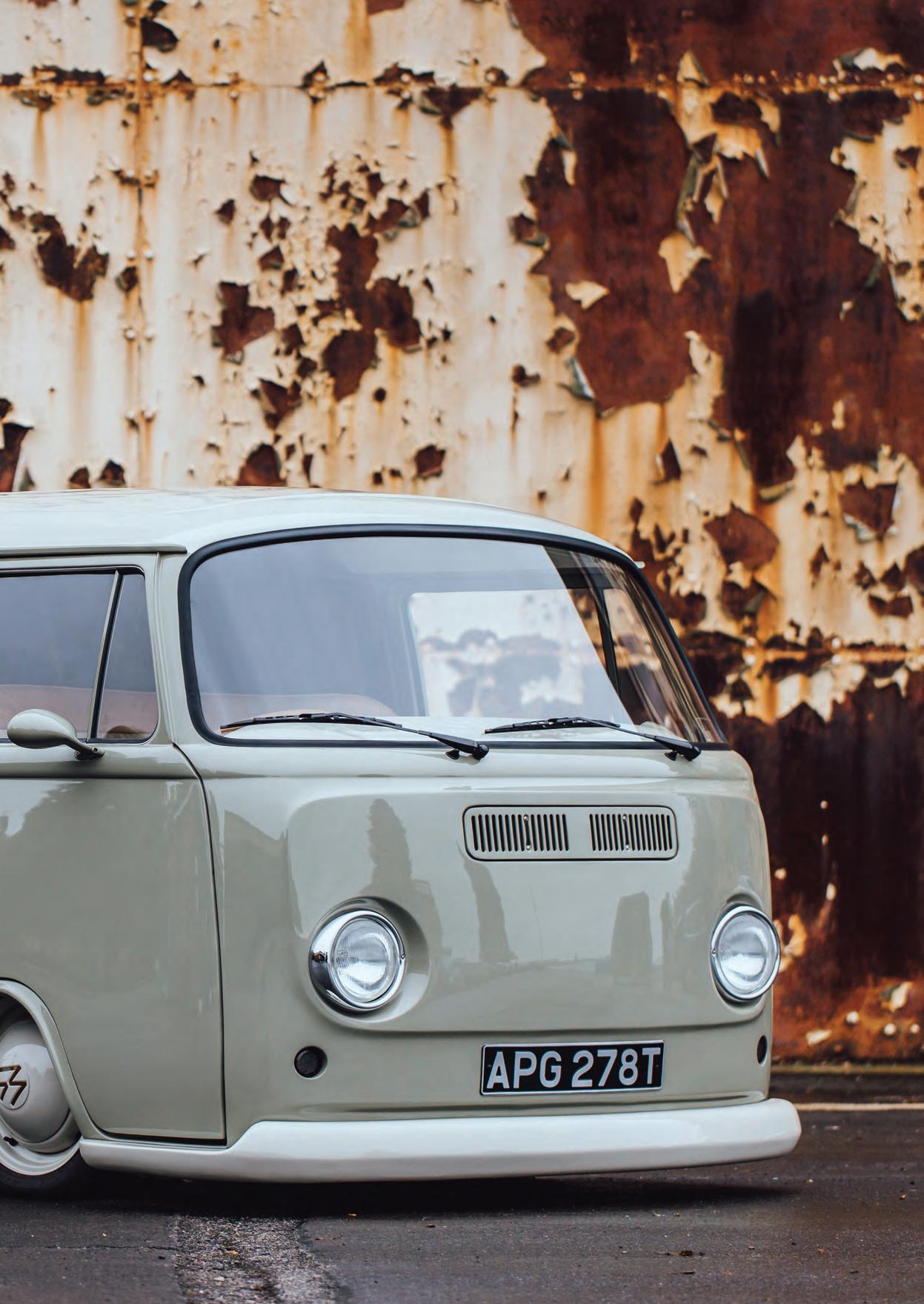
Here’s a quick rundown of the spec of the van in Allun’s words:
“The motor is a rebuilt 1641 on twin 34 ICTs, stock bay IRS gearbox, modified rear arms to accept airbags. Splitscreen 4” narrowed creative air beam running king and link pin, so it sits really low when it’s aired out and handles being low better. There are twin compressors and an air tank mounted under the rear rock n roll bed. The underside is all painted in tinted Raptor to match the body which is VW Reed Green. All the underside components

have been powder coated in Kiesel Grey and the roof, dash and bumpers are VW Pastel White. The wheels are 15” split Commercial wheels and painted hub caps. The Panel Van tailgate came from the EU and is from a German Katastrophenshutz, which was a radio communications van for disaster management. They used to run cables out of the lump at the bottom, but I like it as it’s perfect to use as a handle to open it, now the rest has been smoothed off. I opted to remove the air vents in the tops of the rear quarters and welded in split vents, just because I like the look of it. The front grille has been narrowed and the indicators were flushed then frenched at the bottom. The Late Bay impact beam has been removed and smoothed in order to fit the smoothed Early Bay bumper. Both front and rear bumpers were then moved into the body and it now only has a 10mm gap the whole way around. The side door is now on suicide door hinges and works off a solenoid. The other side door was replaced with a panel welded in and the sliding door rail covers have been blended into the bodywork for the smooth look. The dash has been welded together and has a caddy script blended into it. The glovebox and speedo pod are smoothed as well. I absolutely love how it’s come out and can’t thank Jamie enough!”
When I asked Allun if there was anything that he didn’t like about the car or anything that he wouldn’t do again, he said absolutely


not. He loves it the way it is and wouldn’t change anything about it. I also asked if he’d do another custom car again. He said he’s already started…
Allun would like to thank: Jamie at JF Bodyworks for all his hard work; Steve at 13 Stiches for doing the seats and headlining; Iain Burns at Aircooled Autoelec for the custom loom; Dave at Dave Bespoke Shed for trimming the seats; John at Johnthebrush for the hand-painted signwriting.
So there we go. A cool custom van with an impressive 90s spec mod list that is, dare I say it, modern. Are we going to see a resurgence in custom stuff? A modern spin on those 80s and 90s show giants? This year’s Viva Skeg Vegas show saw Toby and Sal put on a custom car line-up on the Saturday at the front of the show field and the turnout for that was good. Myself and Drummer burnt the midnight oil restoring a 90s show car to take up there – something that I never thought I’d do. The Back 2 89 Facebook page is currently at 6000 members too, so there is obviously an appetite for this class of classic. What do you think? Are we going to see more custom stuff coming? For me, I kind of hope so!










n Superchargers
n Superchargers
n Camshafts
n Camshafts
n Ignition systems
n Ignition systems
n EFI systems
n EFI systems
n Twin-spark kits
n Twin-spark kits
http://joeblow.me
http://joeblow.me
blowjobs@joeblow.me
blowjobs@joeblow.me
WANTTOADVERTISEHERE?PLEASEEMAILadvertising@hayburner.co.ukFORDETAILS


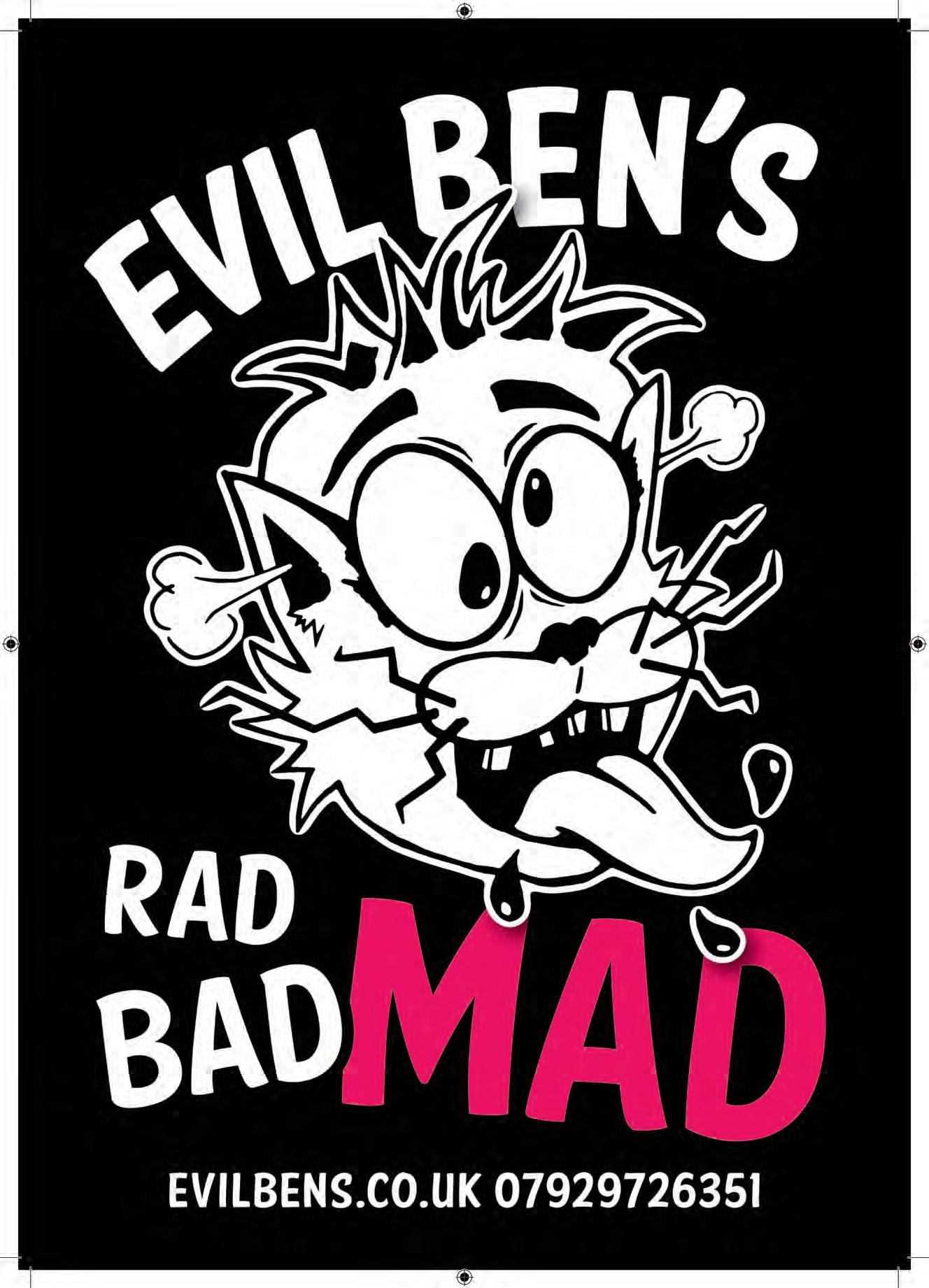
For service parts, accessories and general care for your classic aircooled.

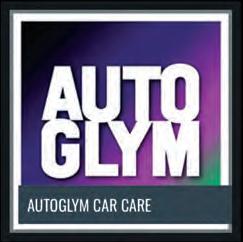










We offer Worldwide shipping and FREE UK postage on all orders over £45 until 28/02/2025!

Supplying quality upgrades for your Beetle, Bus and Ghia plus much more.












If you would like us to promote your Volkswagen event, please enter for free on www.bUGbUs.nEt’s show calendar. Also on bUGbUs.nEt you will find the latest show entries from around Europe.



11TH | WERKSTATTGESPRÄCH AMAG CLASSIC
Schinznach | amag-classic.ch
14TH | X-MAS DRIVE’24
Zürich | See bUGbUs.nEt
30TH | BREZEN DRIVE
Nürnberg | brezendrive.kaeferpiloten.de
JANUARY — 2025


4TH — 5TH | KEVER WINTER FESTIJN
Autotron Rosmalen | keverwinterfestijn.nl
11TH — 12TH | VW VETERANEN WINTERSHOW
Herford | vw-kaefer-wintertreffen.de
FEBRUARY


2ND | MIDLANDS AIR-COOLED SWAP MEET
British Motor Museum | See bUGbUs.nEt
2ND | KKC SWAPMEET
Lommel | dekempensekeverclub.com
MARCH


9TH | SUFFOLK BUGRS MARCH AUTOJUMBLE
Trinity Park | suffolkbugrs.co.uk
16TH | FREDDY FLIES
Ninove | not available as of now
APRIL


25TH — 27TH | ALIVE & KICKINSUFFOLK
Suffolk | aliveandvdubbin.co.uk/alive-and-kickin
29TH — 31ST | KLASSIKERTREFFEN VW-FREUNDE
Seelze | vwfg.de
MAY



1ST | MAIKÄFER-TREFFEN
Hannover | maikaefertreffen.de
2ND — 5TH | BEETLE AT THE BEACH
Overloon | See bUGbUs.nEt
3RD | BUG RUN PICKNICK
Stockholm | bugrun.com

















23RD — 26TH | RUN TO THE SUN
Cornwall | tts.co.uk
29TH — 31ST | BULLITREFFEN KLÄSIHOF
Grünenmatt | See bUGbUs.nEt
5TH — 8TH | ALIVE & V-DUBBIN FESTIVAL
Suffolk | aliveandvdubbin.co.uk
5TH — 9TH | PFINGST VW-BUS TREFFEN
Kaiserstuhl | See bUGbUs.nEt
6TH — 8TH | BIG BUG RUN FUN
Mantorp | bugrun.com
7TH | CAR N BAR
Éghezée | air-watercooled.com
8TH | MEETING AIR-WATER COOLED
Éghezée | air-watercooled.com
13TH —15TH | BOCKHORNER OLDTIMERMARKT
Bockhorn | bockhorner-oldtimermarkt.de
14TH — 15TH | AIR COOLED WITH ATTITUDE
Le Creusot | aircooledwithattitude.com
15TH | OLD WHEEL BIEL/BIENNE
Tissot Arena | oldwheels.ch
19TH — 22ND | OBERWESERBULLITREFFEN
Wesertal | oberweserbulli.jimdofree.com
19TH — 22ND | MIDSUMMER BULLI FESTIVAL
Fehmarn | midsummerfestival.de
20TH — 22TH | AIRCOOLED EMMENTAL
Emmental Arena | aircooled-emmental.ch
28TH — 29TH | AMAG CLASSIC DAY
Schinznach | amag-classic.ch
MAY JULY
3TH — 6TH | HAPPY DAYS
Lünen | See bUGbUs.nEt
11TH — 13TH | VOLKS WEALD
Kent | volksweald.co.uk
12TH — 13TH | PRE79 AIRCOOLED
Staffordshire | pre79.co.uk






8TH — 10TH | LE BUG SHOW
Circuit de spa francorchamps | vwbugshow.be/de
15TH — 17TH | BULLITREFFEN
Zürcher Unterland Rorbas | bullitreffen-zh.ch
15TH — 17TH | SKEG VEGAS VW SHOW
Lincolnshire | vivaskegvegasvw.co.uk
21TH - 24TH | MITTSOMMER VW-BUS TREFFEN
Niederbipp Flühlisboden | vwbusclubbern.ch
2TH — 24TH | JAARLIJKSE VW MEETING
Diepenbeek| limburgsekeverclub.be





4TH — 7TH | BULLI SUMMER FESTIVAL
Wesel | bullisummerfestival.de
5TH — 7TH | VW-KLASSIKER AUF DER POSTALM
Salzburgerland, Abtenau, Postalm | vwpostalm.at
12TH — 14TH | KLEIN ABER FEIN — VW BUS TREFF
Altdorf |See bUGbUs.nEt
12TH — 14TH | BUSFEST
Worcestershire | busfest.org
27TH — 28TH | THE ARDENNEN RENNEN
Ardennen | ardennenrennen.be










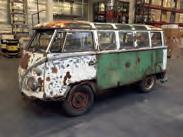


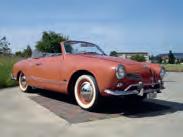



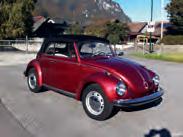





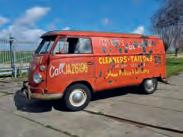













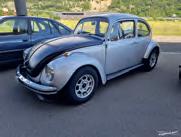





































































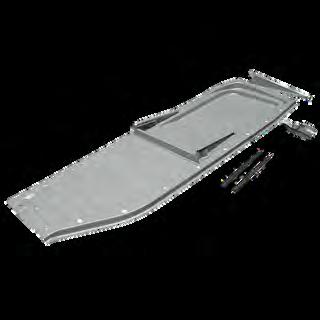











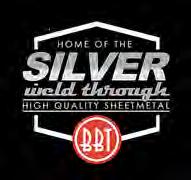


When the humble VW Transporter started to roll off the Wolfsburg production line on 8th March 1950, only one model was produced: the delivery van, or Panel Van. We’re used to calling Beetles Type1s, buses Type2s, Type3s, well, ummm, Type3s, and so on, but internally at Volkswagen the Panel Van was given the designation of Type21. The Type23 Kombi wasn’t too far behind the Panel Van, starting production on 16th May, swiftly followed by the Type22 Standard Microbus on 22nd May 1950.
Other models followed, of course: the Single Cab, the

23-window Deluxe and the Ambulance. Models started to get a further designation to reference things like right-hand drive or left-hand drive, loading doors on the “wrong side”, or even the addition of a sunroof. David Eccles’ handy VW Transporter and Microbus guide has an extensive list of these model codes. For example, a Type21A was a LHD Panel Van, a Type23D was a RHD Kombi, and a Type24A was a LHD Microbus with a sliding roof. Throw in M-codes to explain away a number of other “factory fitted optional equipment” such as extra pop-out windows, safaris, a walkthrough cab or roof

vents, and the huge range of variants available to a buyer perhaps helps explain why the Volkswagen Transporter was, and still is, such a huge success. You could pretty much have your new bus built any way you wanted it. You could even buy Milk Floats, Cherry Pickers, Refrigeration Vans, and the like, all with their own model designation. Sir wants a rear window delete? No problem. Madam wants different gear ratios for mountain conditions? Easy. Apply for a Volkswagen Certificate today, and it will list the spec of your bus as it left the factory.


So, what’s the point of this history lesson? Well, in 1955 when Transporter production moved to the newly built plant at Hannover, Volkswagen introduced M-code M130, “Microbus Deluxe without sliding roof or roof windows”. Yep, that’s right. To order a 15-window Deluxe, you had to stroll into your local Volkswagen dealer, point at a 23-window Samba, and ask for “one of those top of the range ones please but without the


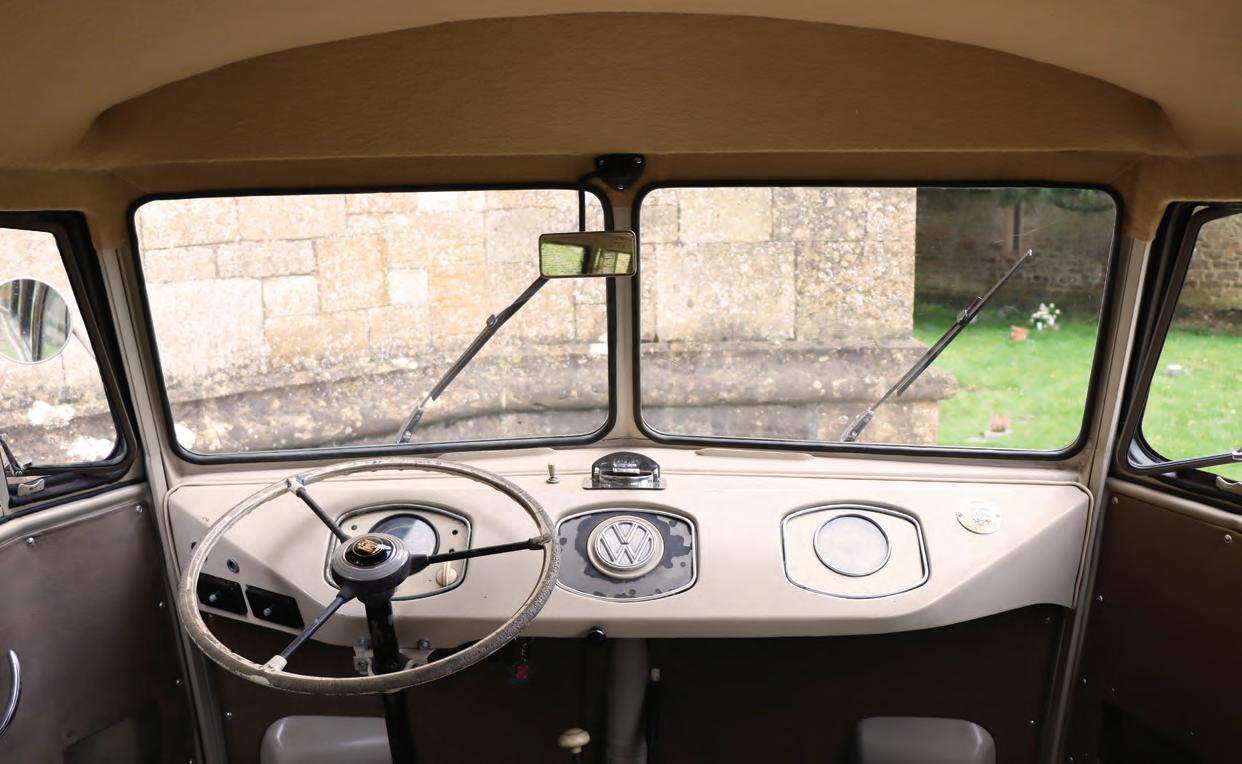
fancy sunroof and skylights”. This arguably strange request is probably why so few seem to have been purchased back in the day. Whilst many “ribbed bumper”, 1955–1958 23-windows still exist today, only about 20 ribbed bumper 15-windows are known to exist worldwide. And if you think that makes them rare, then consider that for many years, zero Barndoor 15-windows seemed to exist. No model numbers or M-codes exist for them before 1955, no factory photos exist of them, and if any were made, none seemed to have survived.
So, this is a rare bus. A very rare bus. And it only exists because Danish taxi driver Søren Madsen decided that he wanted one of those “top of the range Microbuses but without the sunroof and skylights please”. You can imagine the salesperson looking at him with a certain amount of consternation when they realised that they’d have to spend the extra time going to Volkswagen to order a special model rather than selling Søren one from the showroom floor. And that’s exactly what it was at the time. There being no M-code



option to tick on the order form, this bus was ordered as a Standard 11-window Microbus but with the extra rear and side windows added. A Type22S if you like, with the S standing for “Sonder” or “Special model”. The first “deep skylight” 23-windows were built in a similar way. A Standard 11-window Microbus with sunroof was taken from the production line, and the roof and rear end were worked on to add the extra window apertures. Order a factory birth certificate for one of these early Sambas and it’ll show as a Type24A, which designates an 11-window Sunroof Bus. Peel back the headlining and you’ll see some very rudimentary welding and lead work where it was rolled over in the factory to have the extra windows added to turn it into a 23-window Deluxe. Check out the vin tag, stamped and added after the conversion, and you’ll see it stamped as a 24S – a Sonder-bus; but ask the factory about the S designation and they’ll tell you that no such type exists in their records and swear blind that you own an 11-window Sunroof Bus. It was a very interesting period of development for these old vans, and there are some great factory photos on thesamba. com of deep skylight 23-windows mid-way through their conversion. Much like the ratios of existing Hannover-built Deluxes, quite a number of early 24A/24S Sambas still exist today, including a few crash-damaged and repaired buses that have confusingly had their roofs replaced long ago, but this 22A/22S 15-window is definitely a much rarer beast.
Søren wasn’t alone in looking to Volkswagen for his next fareearner. So popular was the Microbus as a taxi in Scandinavian countries that Volkswagen even sold an off-the-forecourt Taxi, complete with taxi light, fare meter, glass cab divider, sidestep, etc. through Danish importer Skandinavisk Motor Co. Alternatively, if you didn’t need the full “bells and whistles” “Taxa” generally favoured by fleet companies, then an individual could simply use his own vehicle and charge whatever rate was agreed. I guess a modern comparison would be a larger local taxi firm operating from an office next to your local train station versus the guy who lives on your


estate and uses his old diesel estate to pop local pensioners to the shops. That guy was Søren, and he plied his trade in and around the Abenrå-Sønderborg area of Southern Denmark for ten years, before retiring to the town of Skive and selling the bus in March 1963 to an N.J. Sieg who resided in the town of Nykobing.
Sieg, an engineer, had purchased the old Volkswagen with plans to do some travelling around Europe. In fact, I have a lot of old paperwork with the bus including the bill of sale, road tax, and his international insurance papers for the van. Sieg set off in 1964 on a fateful trip to Norway, where he broke down repeatedly in the old bus and, once he finally made it home, decided that an 11-year-old taxi was not the vehicle for him


anymore and decided to park it up.
Most people might leave such a vehicle, unwanted and unloved, in a shed or at the bottom of the garden, especially since scrapping a vehicle was such an expensive undertaking in Denmark in the 1960s. Sieg, though, had an old quarry on his land and decided that this made for a good parking place. Out of sight and out of mind. Several years later, while building a new summer house on his property, this same quarry served as an excellent dumping ground for all the excess dirt, trees and general building waste. With the bus now half-buried, Sieg played his masterstroke and piled old rocks on top of what was still visible, leaving the cargo doors open to create a new home for a pack of local foxes. And that was it. The old taxi was dead and buried.


Fast forward to the late 2000s, and a Danish Volkswagen enthusiast by the name of Kurt Sorensen got talking to an oldtimer at a car meet and was told the story of his brother’s old VW van. Six months later, Kurt and his father met the guy again and the story started to flesh out with talk of it being a “1950’s Deluxe bus”. Old paperwork for the van had by now been located but the brothers hadn’t managed to find the exact resting ground of the old bus. Finally, the brothers contacted Kurt and his father to say that they’d spent yet more time digging in the old quarry and had found the front end of the bus, exactly as it had been parked, complete with steering wheel and Deluxe dash still in place. The brothers had a neighbour with a digger and wondered if Kirk and his dad fancied making the hour’s journey to assist with the exhumation. Well, what would you do?
So, built in 1953, buried in 1968, and dug up again in 2011, Kirk and his dad now became the proud owners of the world’s worst, hugely rare, 15-window Barndoor bus. It had been an adventure but they didn’t have the appetite for trying to restore a vehicle that had rusted to such a degree that it came out of the ground in sections. The obvious choice in 2011 for any self-respecting Scandinavian looking to home such a vehicle was to ring anyone with a +44 international dialling code. A call was placed to Barndoor enthusiast Rich Burrows, who was way too sensible to take on such a project himself and passed it onto Welsh VW salesman Dai Watkins. A ferry to Esbjerg was duly booked and, before too long, the Barndoor found itself residing next to a few other lumps of precious Wolfsburg tin in an old barn


somewhere in South Wales. Spring 2017, and the Welshman and I had a sleep-deprived conversation on a long Scandinavian road trip that somehow resulted in the rusty remains ending up in my unit. Eventually I dug them all out again and tried to work out what exactly could and would live again from the twisted and rusty pile of bus that I now owned. I’ll admit that it didn’t look so good to begin with but, starting with the chassis remains, I made it my mission to clean up and save whatever could be saved, replacing what couldn’t with as much original VW metal as I could source.


Type29 tackled the welding for me, after proving just what can be restored with Florian’s mammoth ’51 Samba build, and gradually the shell started to look like a bus again. Meanwhile, I set to cleaning up all the old glass, Deluxe trim, running gear, and anything else that looked like it could be reused.
The welded shell eventually made its way to my good friends at Beetle Magic near Dorchester, but you guessed that already, I imagine. Once you find good people, skilled people, honest people, friendly people, to work on your cars, then you don’t
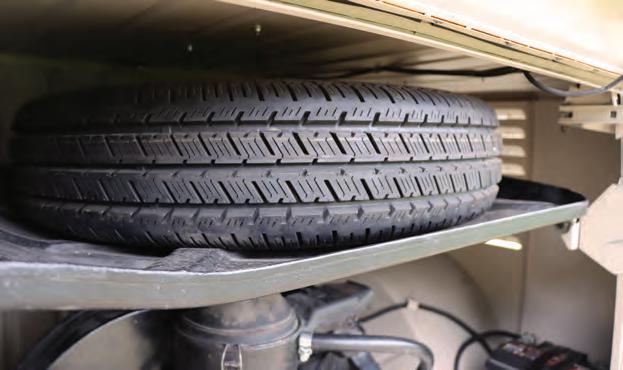



change the formula. These guys have become close friends over the years and I wouldn’t take my old Volkswagens anywhere else for this work. In their workshop, more welding, spannering, wiring, painting, polishing and fitting-out took place over the course of the next 12 months, resulting in a clean bill of health from the MOT man, and a bus that turned out almost exactly as I’d pictured it. I’m a huge Barndoor enthusiast but also a massive 15-window fan. I’ve owned a few ribbed bumper 15s, but this old taxi from early January 1953 really is a Holy Grail bus for me and I’m very happy to have saved it, quite


literally, from the grave. It was a huge undertaking, and I’m very grateful to Ben and Ollie for humouring my optimistic whims and assisting me in saving yet another in a long line of tired old Volkswagens. I guess I should give old Søren a nod too, for being maverick enough to go and order it in the first place for his taxi business. Sambas are cool, for sure, but you have to be a certain kind of badass to order one back in the day with an optional sunroof and skylight delete. Yeah, Søren. I’m talkin’ to you.















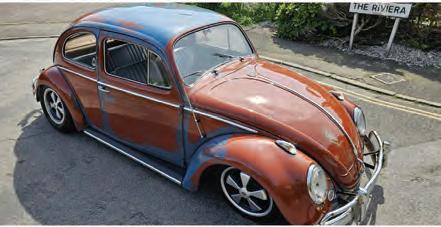









































I feel a bit of a fraud calling this article ’49 Time, due to the fact that I’ve made around zero progress on this project since my last instalment, so this is probably a good time to bail if you have no interest in reading about me explaining myself and touching on other topics.
I guess I should begin by explaining why my progress on the ’49 has slowed. I can’t use the mental health card as I’ve been particularly good in that respect (touch wood, etc.). I can’t blame the weather as it’s inside. I can’t say I’ve been too busy as I managed to find time to read at least a book a week and also run my first 5k … so what’s
the problem? I think it’s mostly down to a lack of funds, which has a knockon effect when it comes to overall enthusiasm. Let me be completely transparent and explain. The project has got to that stage when it requires things that are a little above my skillset, such as upholstery and engine building (my engine building history isn’t great). These days in particular you need deep pockets to have an expert professional do anything on your car. The knock-on effect has been a frustration that I can’t do these things myself and can’t afford to have them done for me right now, so I then ignore all those little jobs I still need to go through.
I believe that the last issue ended with me trying to get the project to Skeg Vegas as I’d made a promise to Toby to have it displayed there with the body separated from the pan. It made it and was an absolutely fantastic event. I felt quite proud watching people look around the car, along with a bit of friendly banter with the guys from Type 2 Detectives who took it upon themselves to put the body on a slammed-out floor pan while I was taking a break from the stall. It actually looked kind of cool lowered, but not quite cool enough to make me deviate from my original “stock” plan.
Before the show I was adamant that

any job that was done on the car prior to Skeg had to be done and dusted so parts were fully operational and I wouldn’t need to go back on myself. Annoyingly, as the Skeg deadline loomed, corners began to get cut and there are definitely aspects of the running gear I’m not happy with. For instance, the clutch pedal is catching somewhere inside the tunnel, a RHS front backing plate issue, rear drums don’t fit at all and need machining, and the steering box seems to have sprung a leak. None of these are particularly fun jobs so I’ve not really had the enthusiasm to get on with them.
So with no funds, I need to get on with what I can. There are window runners to recondition and things that still require finessing. I’m not really sure where I go from here. The price of everything is going up up up, and this seems to be leaving me with less and less disposable income when it comes to things like building expensive engines. Up to this point I’ve always had a good collection of VW-related stuff to sell. Need a gearbox? It’s ok – I’ll sell that set of original Gas Burners. Need tyres? It’s ok – I’ll just sell that Petri horn button. But over this build that stash has got smaller

and smaller to the point where if I need something for this project I have to actually find the money. And as I’m sure many of you know, it certainly doesn’t grown on trees.
Just to clarify, I will complete this car. I have to complete this car. It just might take a little longer than first expected.
Anyway, it’s not all bad around here. We’ve just finished a fantastic show season and business is good. I also think this magazine might be our team’s best work yet – or at least the issue I’ve been happiest with out of 52 editions. I

recently made a decision to take bit of a step back from things such as YouTube and social media and really concentrate on good journalism and photography. Don’t get me wrong – we will always have a digital presence. If there’s something worth putting online through our various platforms we will. I just have zero interest in being a TikTok sensation. I want us to spend our efforts putting out the best magazine we can, instead of this disposable digital “content” that’s swiped away and forgotten forever.
I understand this attitude is old-fashioned and goes against the grain when everyone seems to be going in the digital direction. I know I run the risk of being left behind but I don’t want to deviate from what I set out to do which is to put out a magazine that’s independent, informative and hopefully inspirational. I love what I do and as long as you keep reading we will keep on writing with an aim to just keep making the magazine bigger and better.
Before I leave you, I just want to say that it means the world to me that the magazine is still growing after 52 issues and, as always, I want to say a huge thank you to everyone who has ever subscribed, advertised, supported, contributed, put a sticker on their car or represented us with a T-shirt. We are lucky to have you.

Thank you all for being a part of it.


